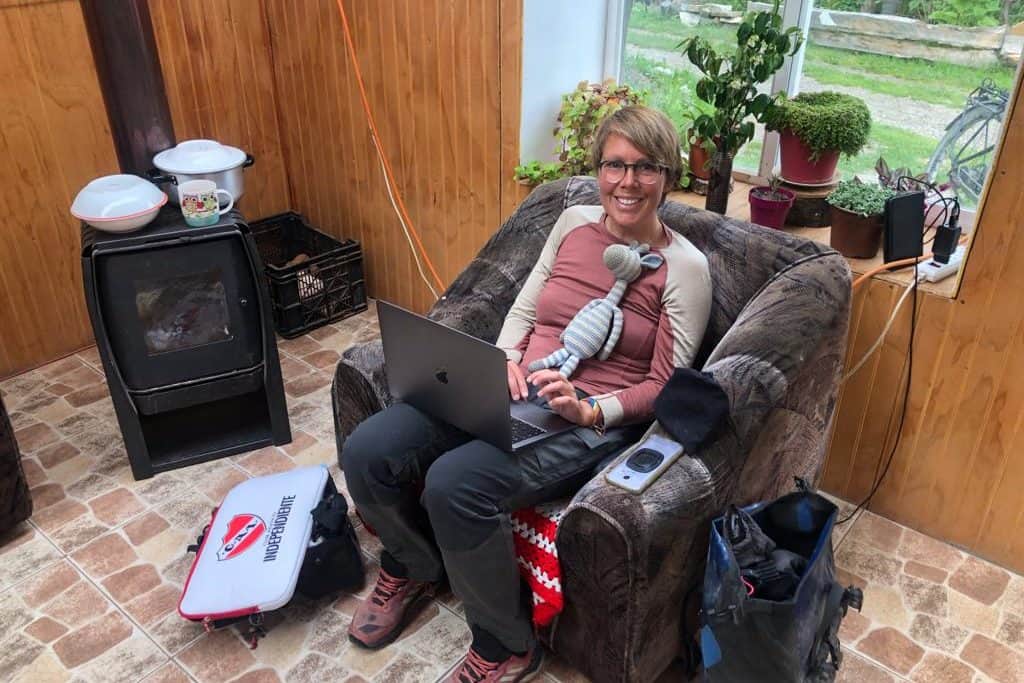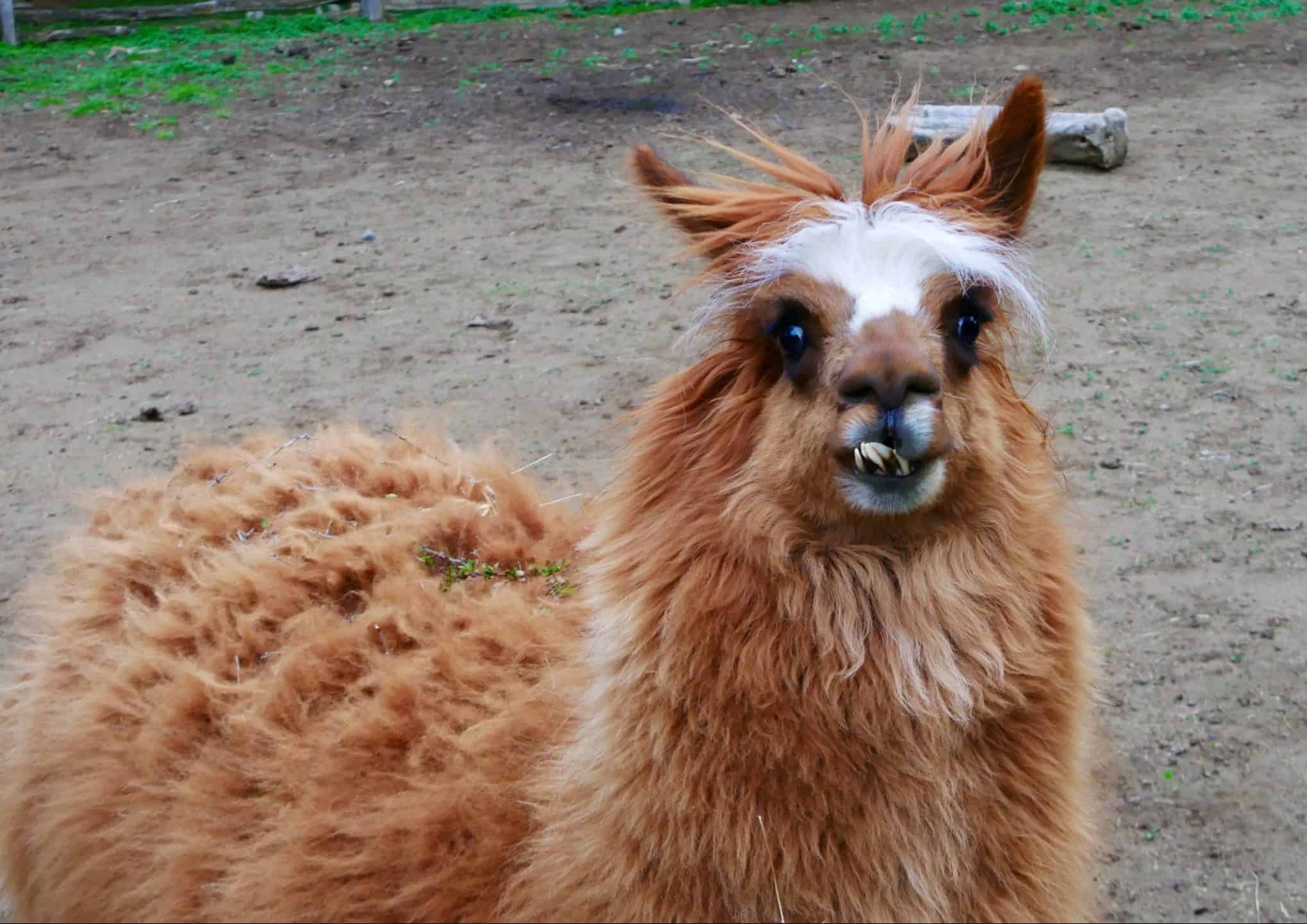
Carretera austral part 1
With bags loaded with groceries from Argentina, we cycle to the Chilean border. There the customs officer asks for the “papers” of our bikes. Papers? It’s a bicycle! Eventually he draws up a little document himself. Color: gray, brand: Santos, wheel size: 26″, year of construction: uuhm, 2015? Once our panniers are superficially checked for contraband (vegetables, fruit, cheese, honey) we are allowed to pass. Welcome to Chile!
The first thing that strikes us is the quality of the road surface. Where in Argentina the “ripio” (gravel) consists of large pebbles, here we drive on a narrow but firmly driven sand-and-gravel road to the provincial capital of Coyhaique, the largest town on the “Carretera Austral” and located about halfway along that route. The Carretera Austral… A route we have been looking forward to for some time. It is a road 1240km long, connected in some places by a ferry. Construction of the road began in 1976 with the goal of connecting a number of remote communities to each other and the rest of Chile. Final construction of the route as it is today was not completed until 2003. Only about 100,000 people live in this sparsely populated area, more than half of them in Coyhaique. Characteristics of the Carretera Austral are fjords, forests, glaciers, lakes and … rain! No green without rain… and the Carretera Austral is GREEN!
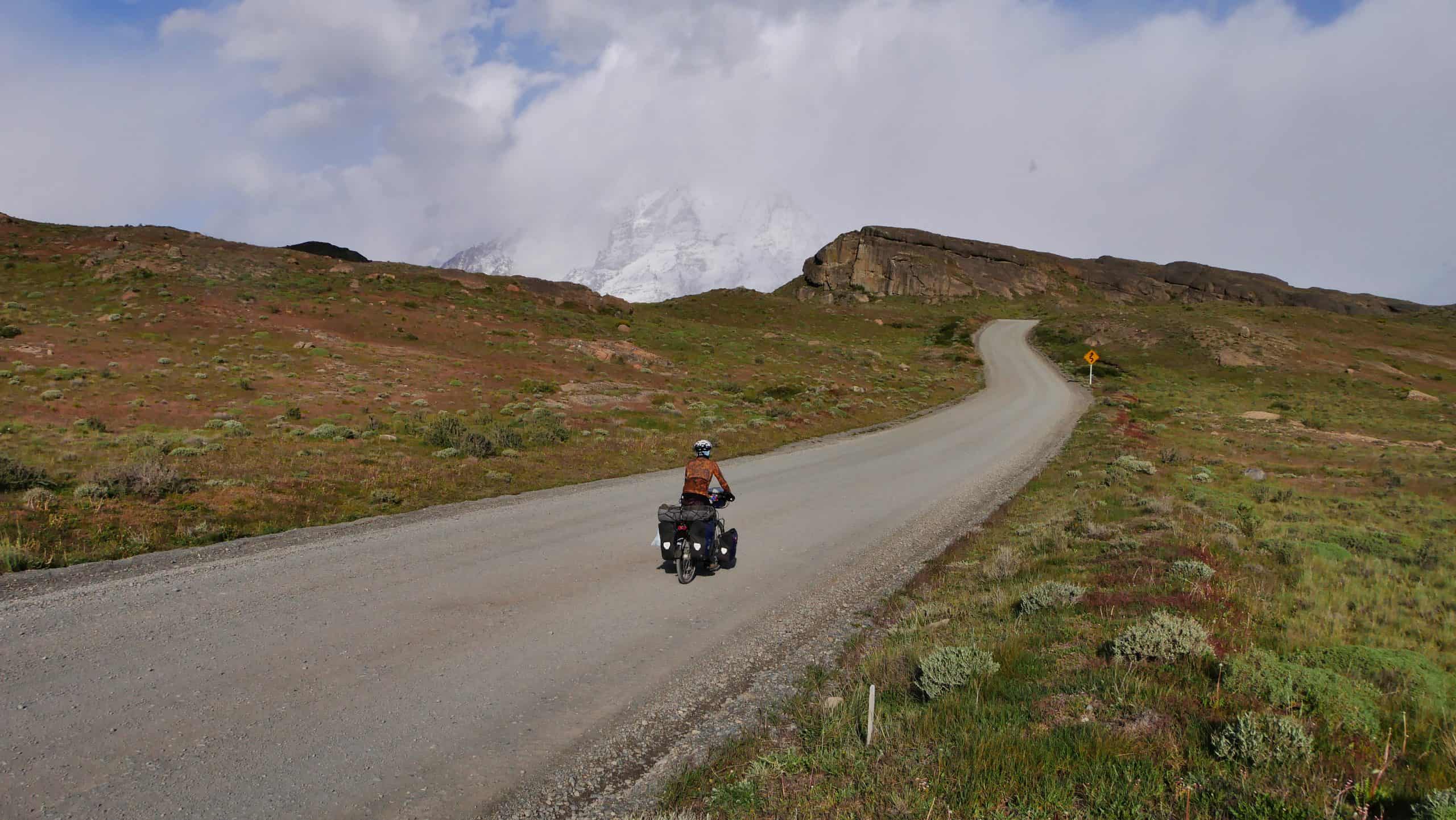
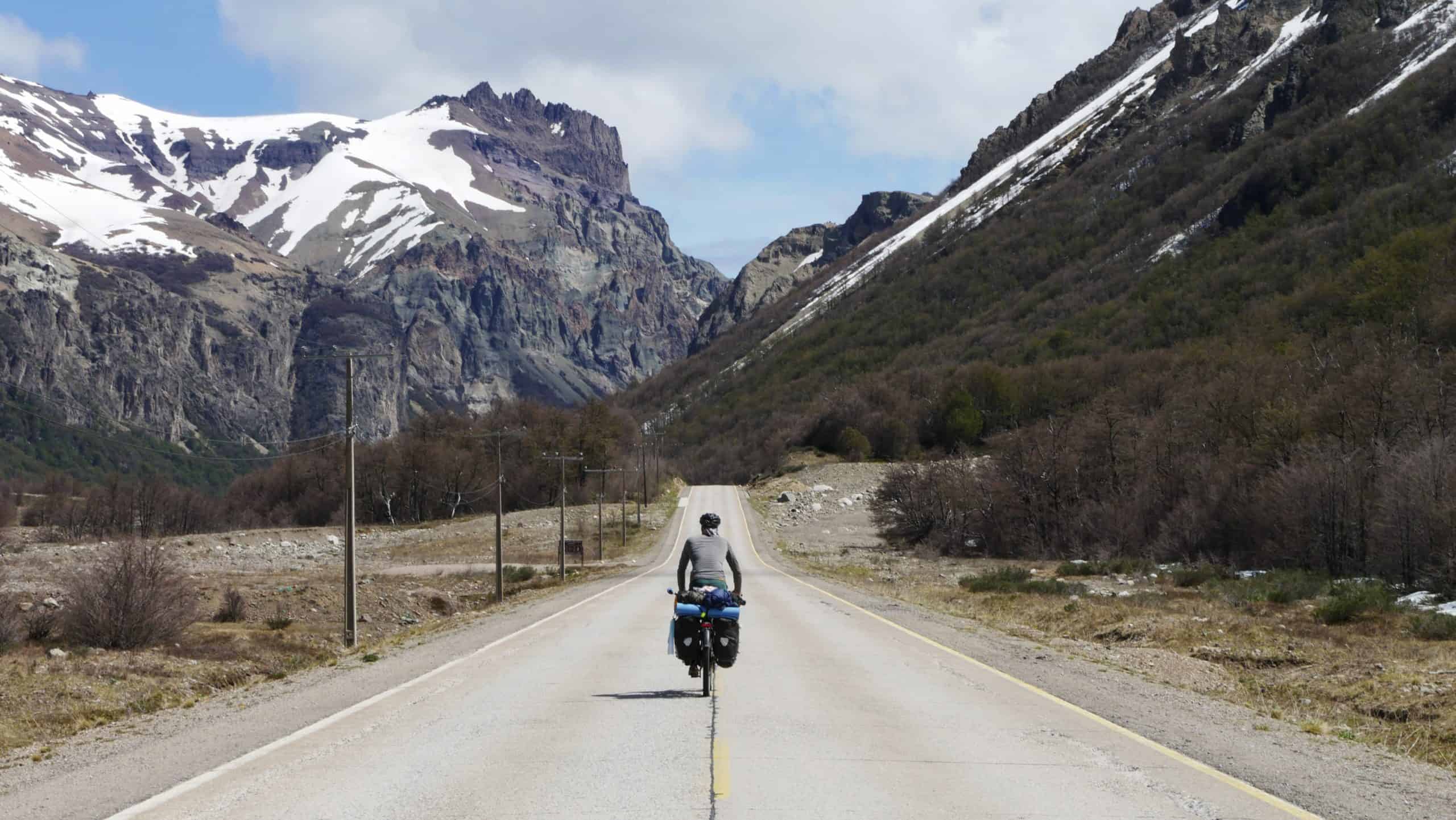
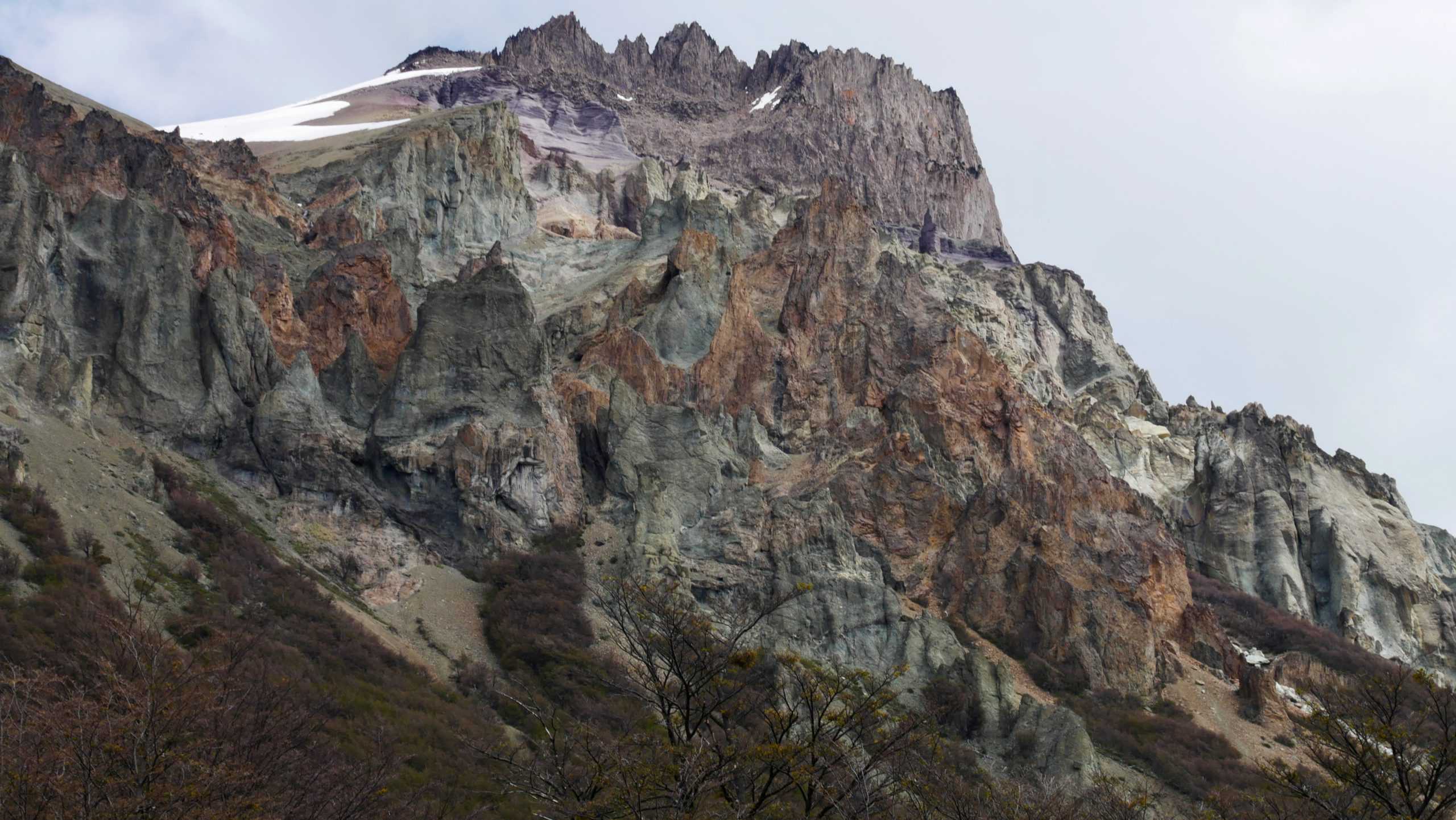
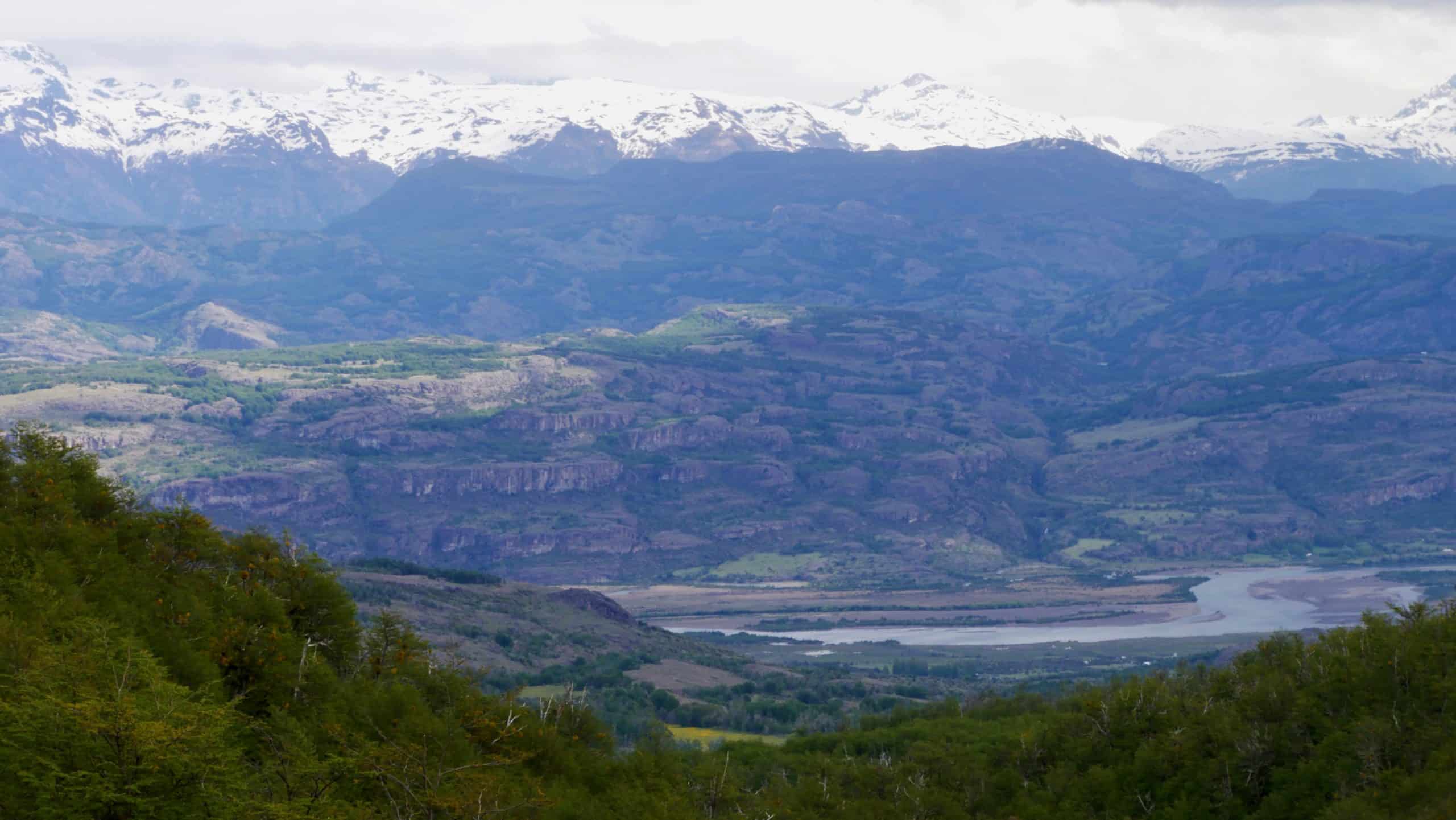
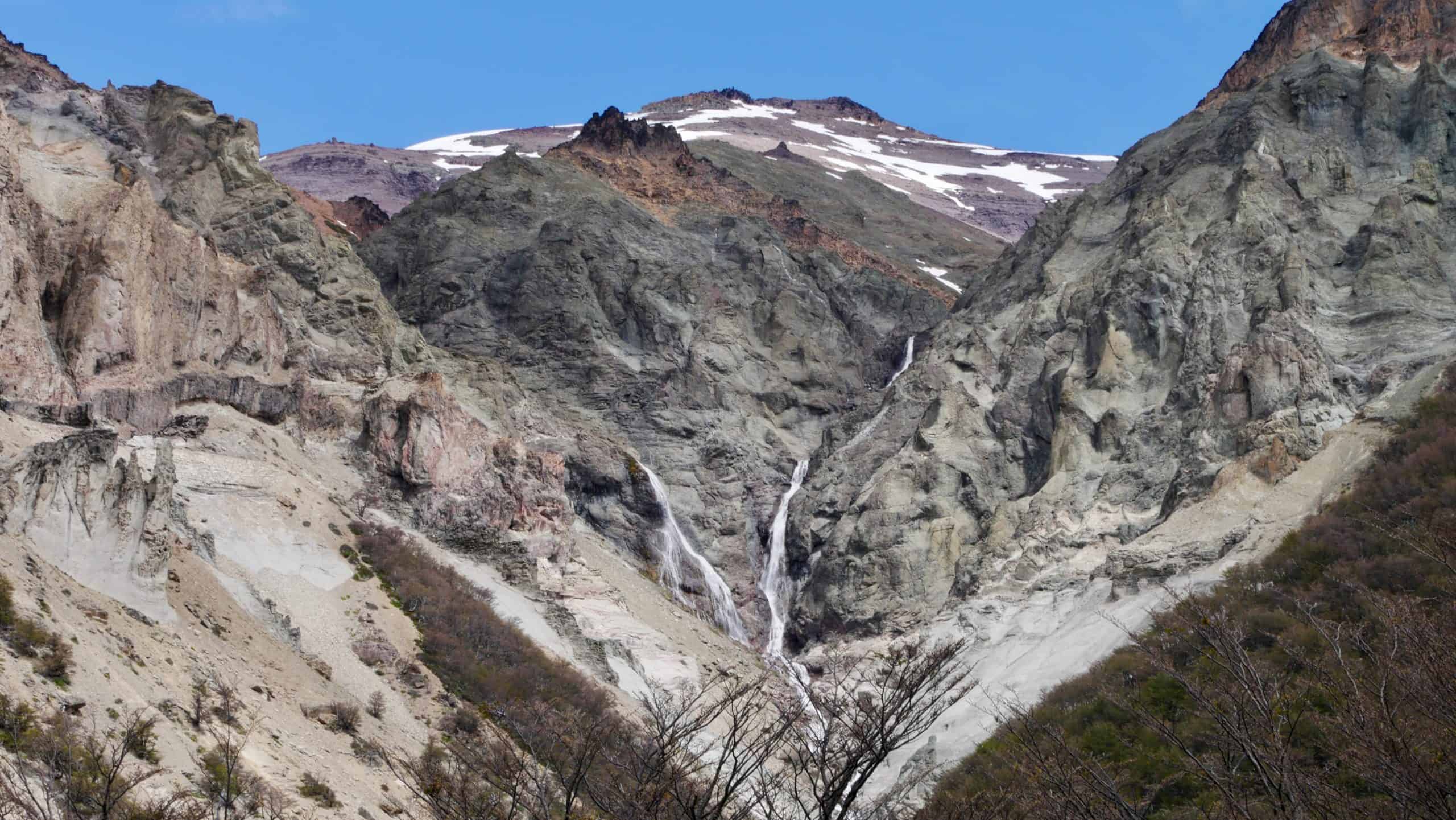
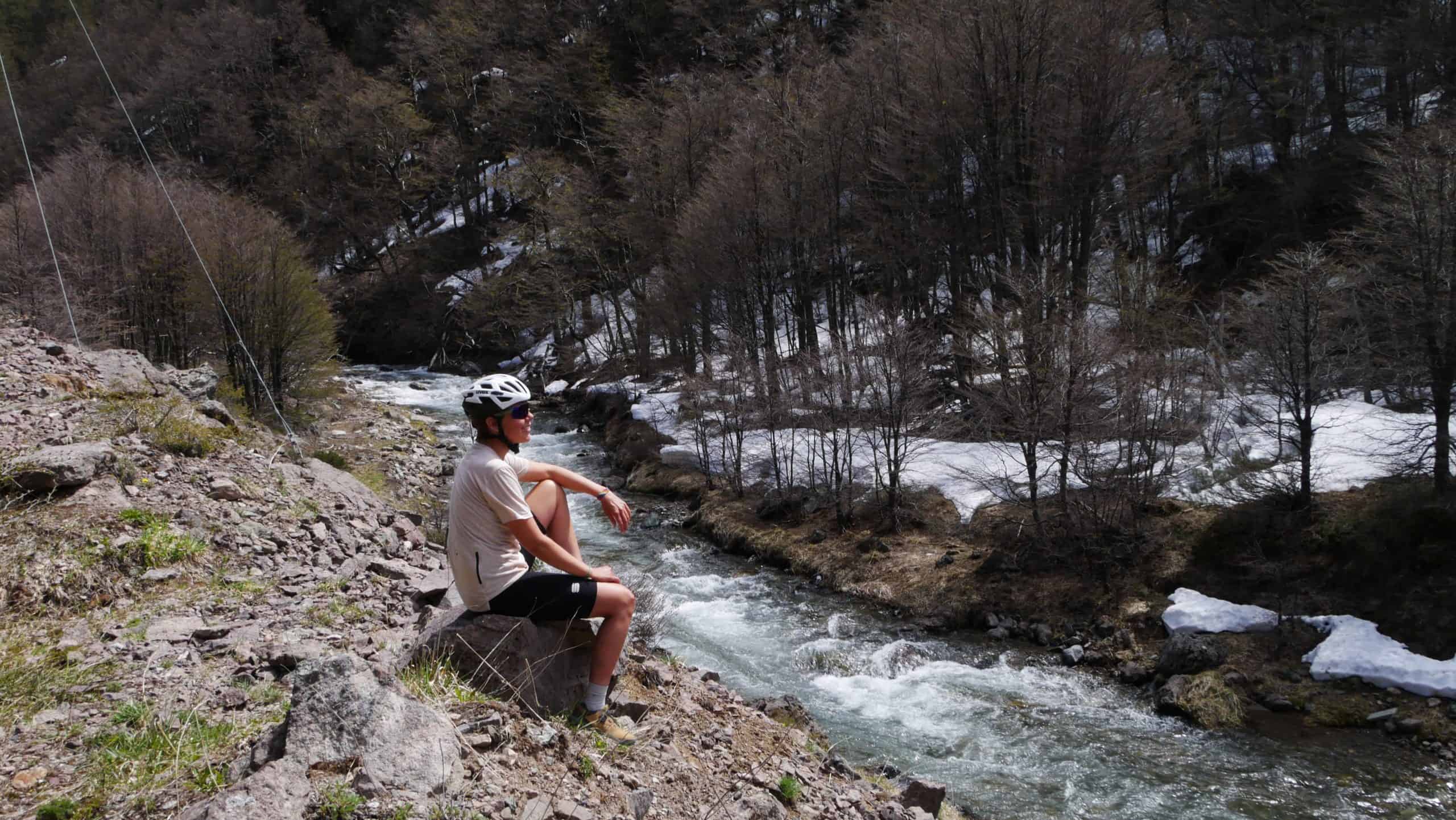
After a couple of rest days with a WarmShowers family in Coyhaique, we begin the trek south. The altimeters on the schedule don’t lie. Over 6000 altimeters spread over more than 500 kilometers. Because my knee problems have been acting up lately, I am a little apprehensive about what is to come. We set ourselves no goals. Day by day we decide to see what we can and cannot do. Our only limitation is the lack of provisioning along the route.
When, toward the end of the first day of cycling, we look for a place to camp, it turns out to be made more difficult once again because all the land has been “fenced off. Here too, as in Argentina, much of the land along the road is privately owned. It is natural land, be it forest, steppe or pasture, but it is fenced off to allow horses, cows or sheep to graze. We decide to knock on the door of a roadside cottage with a flock of sheep and, much to my delight, some alpacas on the property. No one answers. I walk around to the back door and knock again. A woman peeks at us from behind a curtain. A moment later, she opens the door with her hand on her heart and sighs, “You scared me. I was afraid robbers were at the door.’ So that’s how unusual it is for someone to come knocking on your door out of the blue here. When she has recovered from the shock, she warmly points out a place in the meadow where we can pitch our tent. She thinks it is only a good idea that we camp “safely” with her instead of in the wild along the road. Even though this area is known to be HIGHLY safe. Clearly a concerned ‘mother’.
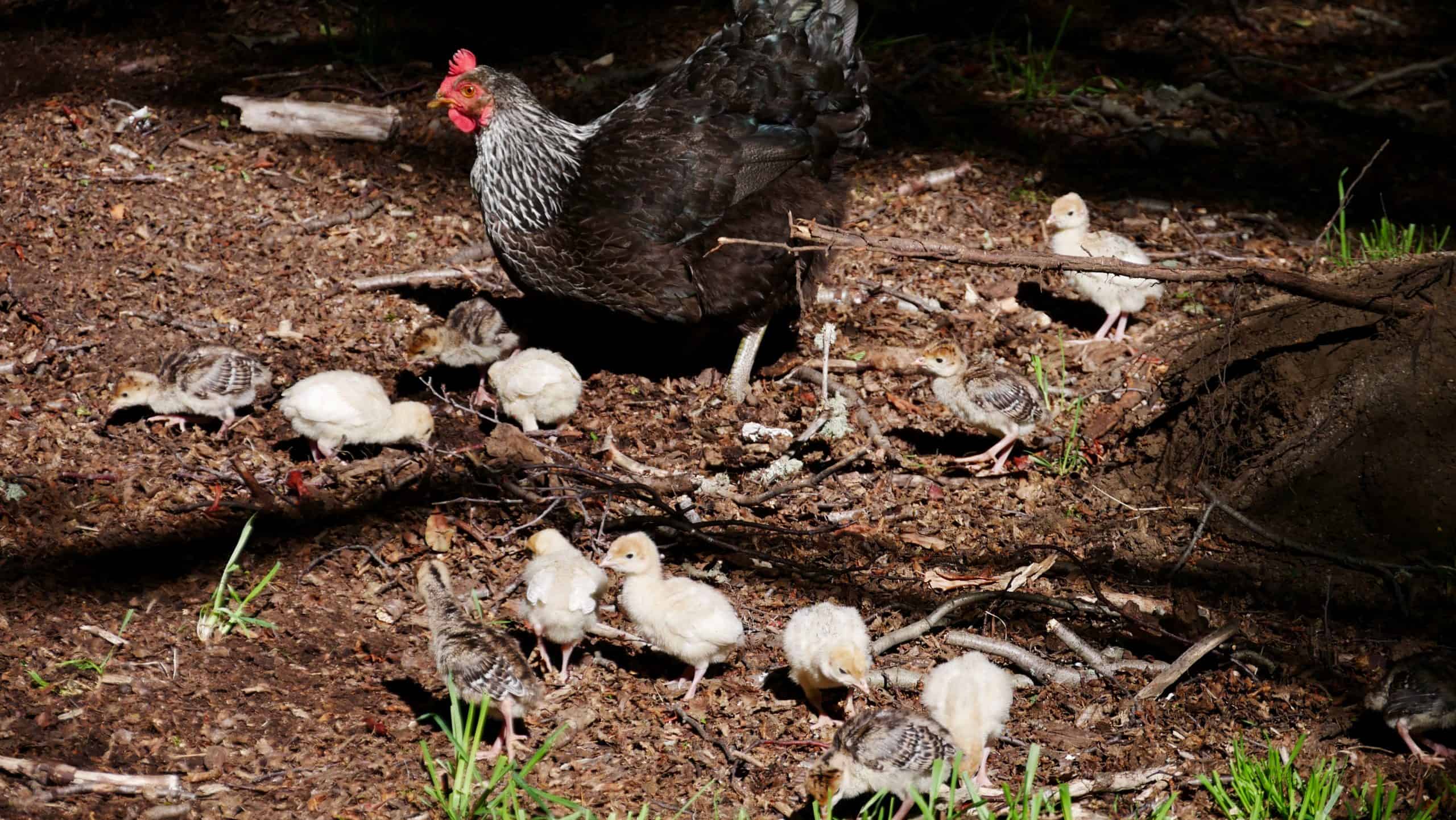

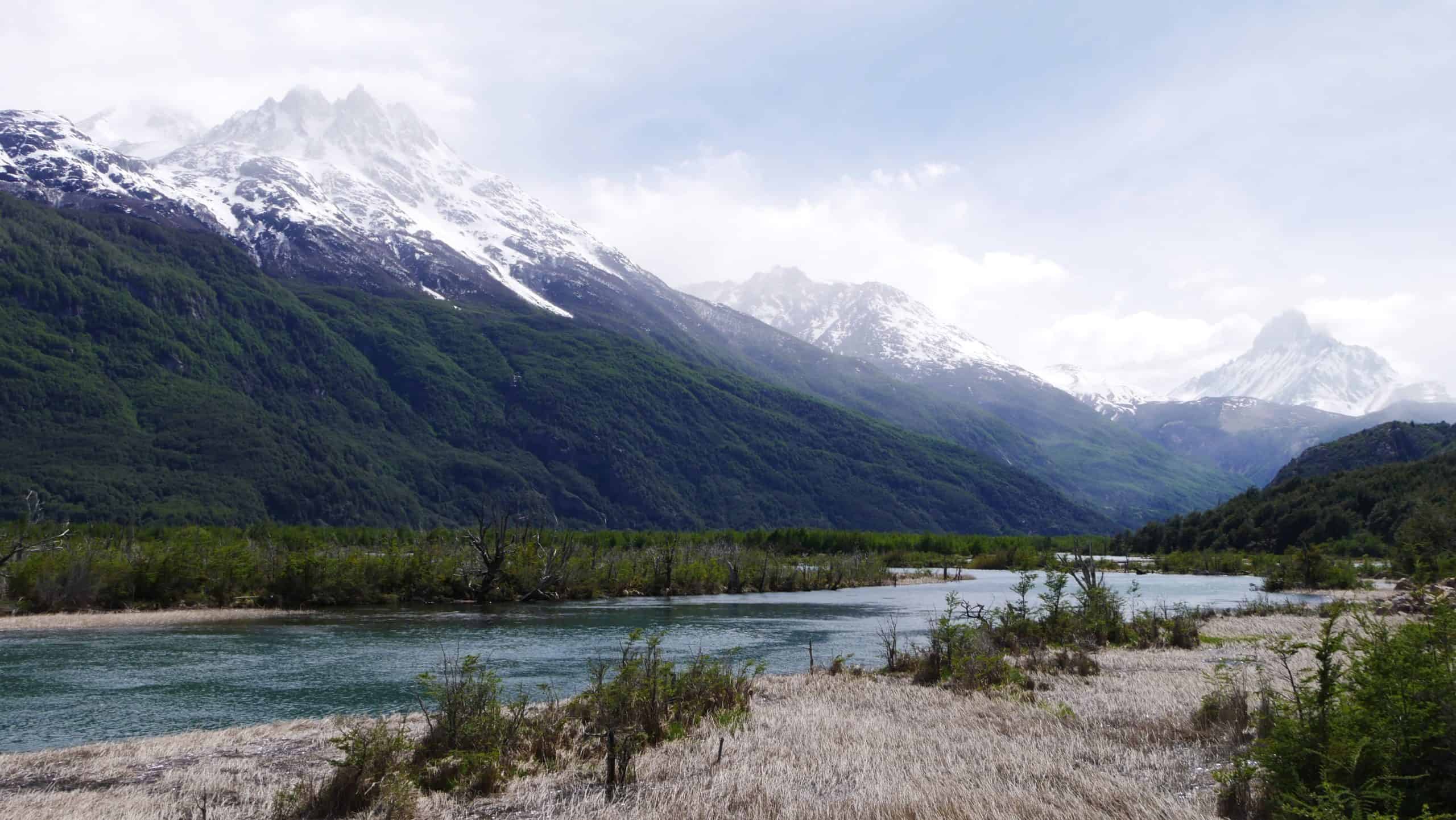
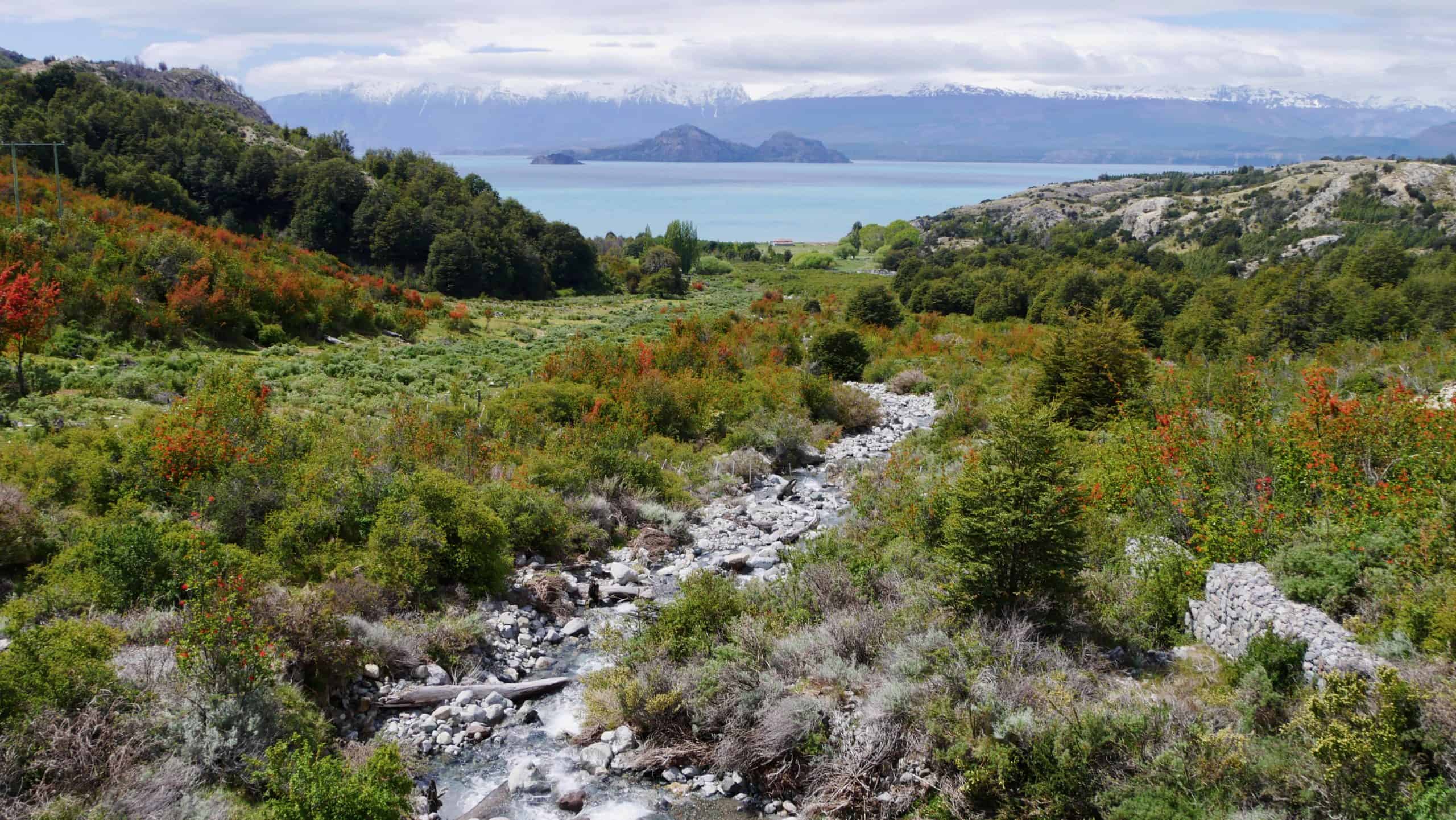
It is chilly on the Carretera Austral and regularly some rain falls from the sky. Real downpours, with one exception, fortunately remain largely absent. Tourism is being embraced by the region and in the villages that are there, campground and restaurant owners are charging top dollar for their services. After one expensive lukewarm squeaky-clean coffee, we learned our lesson. Our instant coffee and milk may not be the best, but at least it’s warm and plentiful. As a cyclist, that’s usually where your priorities lie when it comes to food and drink.
Once more we are guests on someone’s property, next to a goat pasture and again in the company of two alpacas. What funny animals they are! One big bunch of hair with four short legs sticking out from under them, two big dark eyes poking out and, in the case of these two, teeth that make you smile. I have already taken them into my heart. How wonderful creation is! I bought eight fresh eggs from the owner. Boiled eggs are a good substitute for cheese on bread. We temporarily replace the honey with cane sugar. So we temporarily find a way around the products for which the main price is asked here.


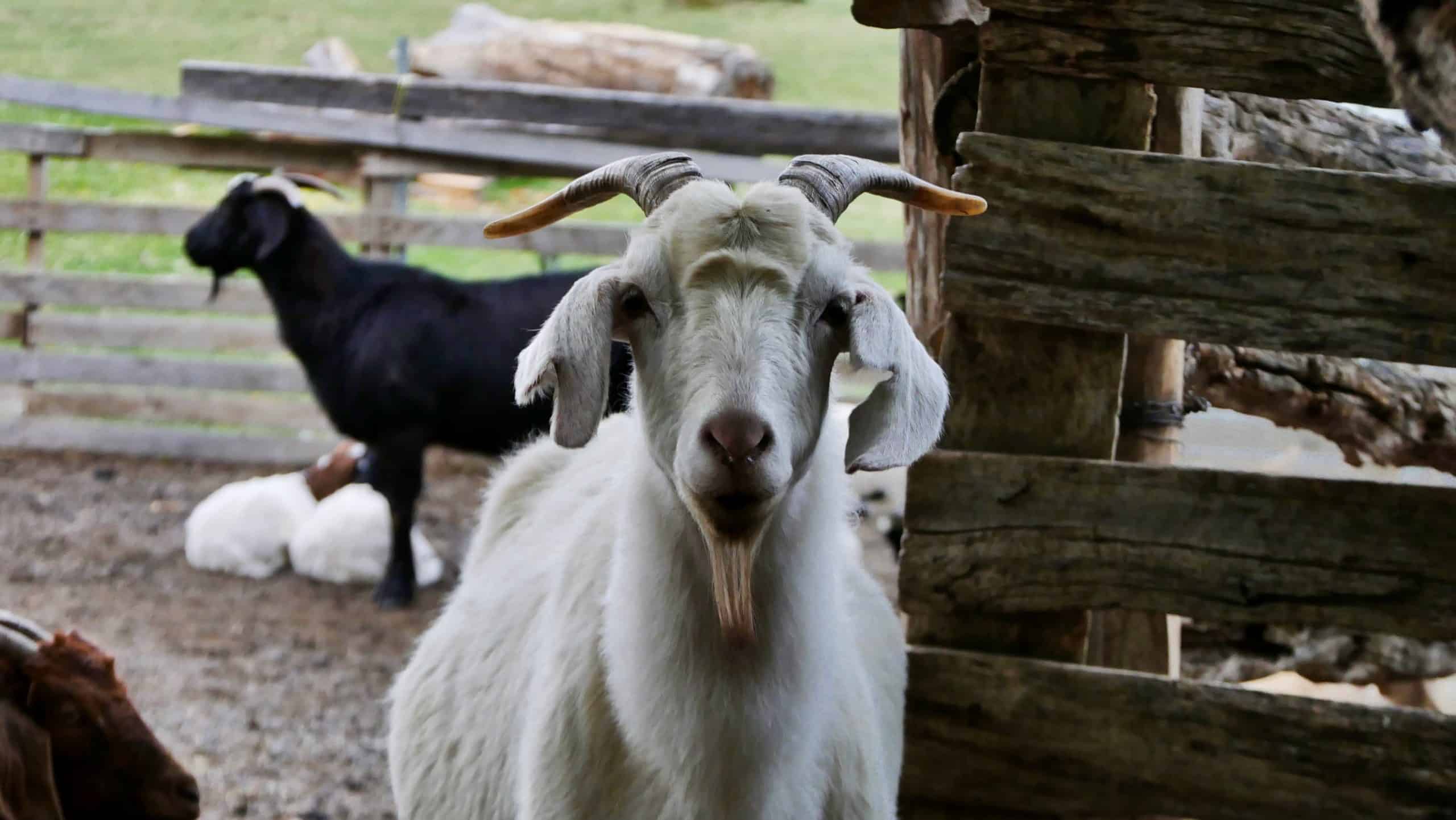
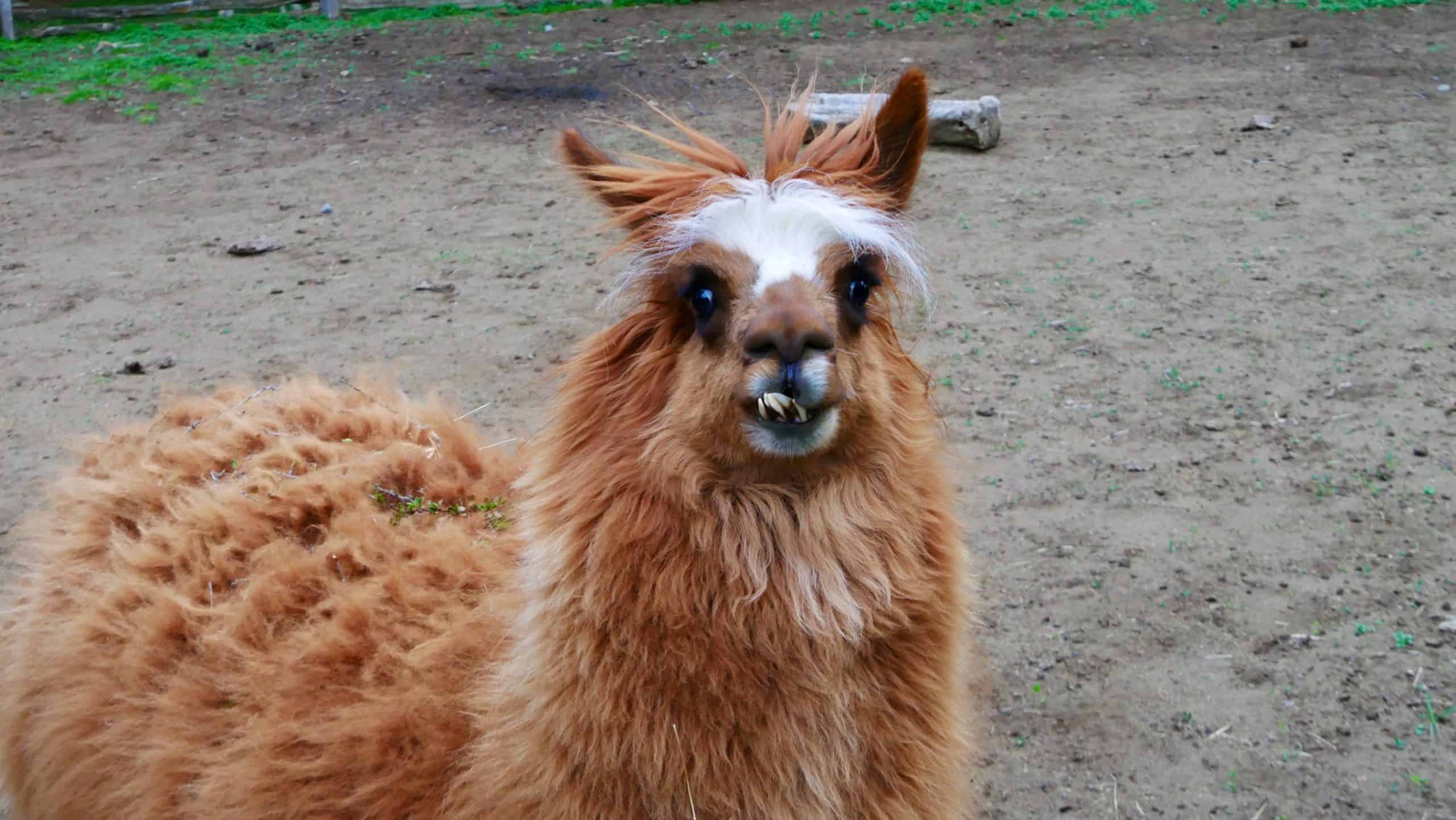
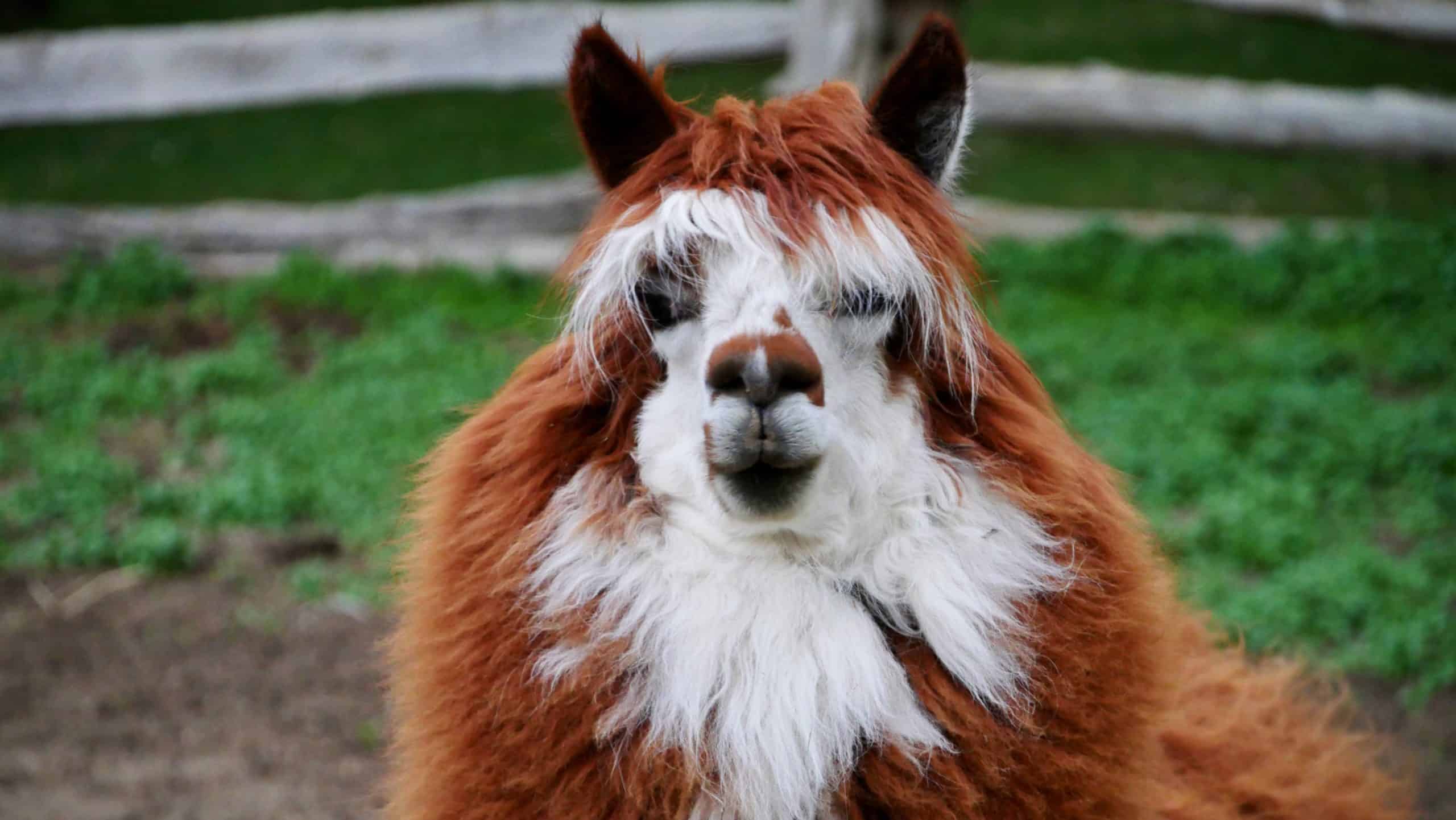
During the ride on the Austral, the pain in my knee increases. It worries me. Not so much for the physical condition of my knee, which I know is fragile and damaged, but for the rest of our trip. It feels so cruel that “just as we are starting one of the expected highlights of our trip” I have to start thinking about alternatives. Over the lukewarm expensive coffee, tears roll freely down my cheeks for a moment. My heart hurts at the idea that I won’t make it to Peru. That I won’t be able to admire the colorful traditional mountain villages and the many alpacas there from a bicycle. It is still far in the future, yet for a moment I cannot help but hang my head.
When my tears have dried we roll to a campsite in the village. First a hot shower, then food and then further reflection. We agree that if my knees really make biking impossible, it doesn’t have to mean the end of our trip. There are other ways to travel independently. And as for the short term. Fortunately, we already know that we will be repeating the stretch of Carretera Austral we are cycling now from the south. So it is quite surmountable to cover the remaining 350km of the route partly by hitchhiking. All the sooner we will arrive at a suitable place to give my knees a rest.
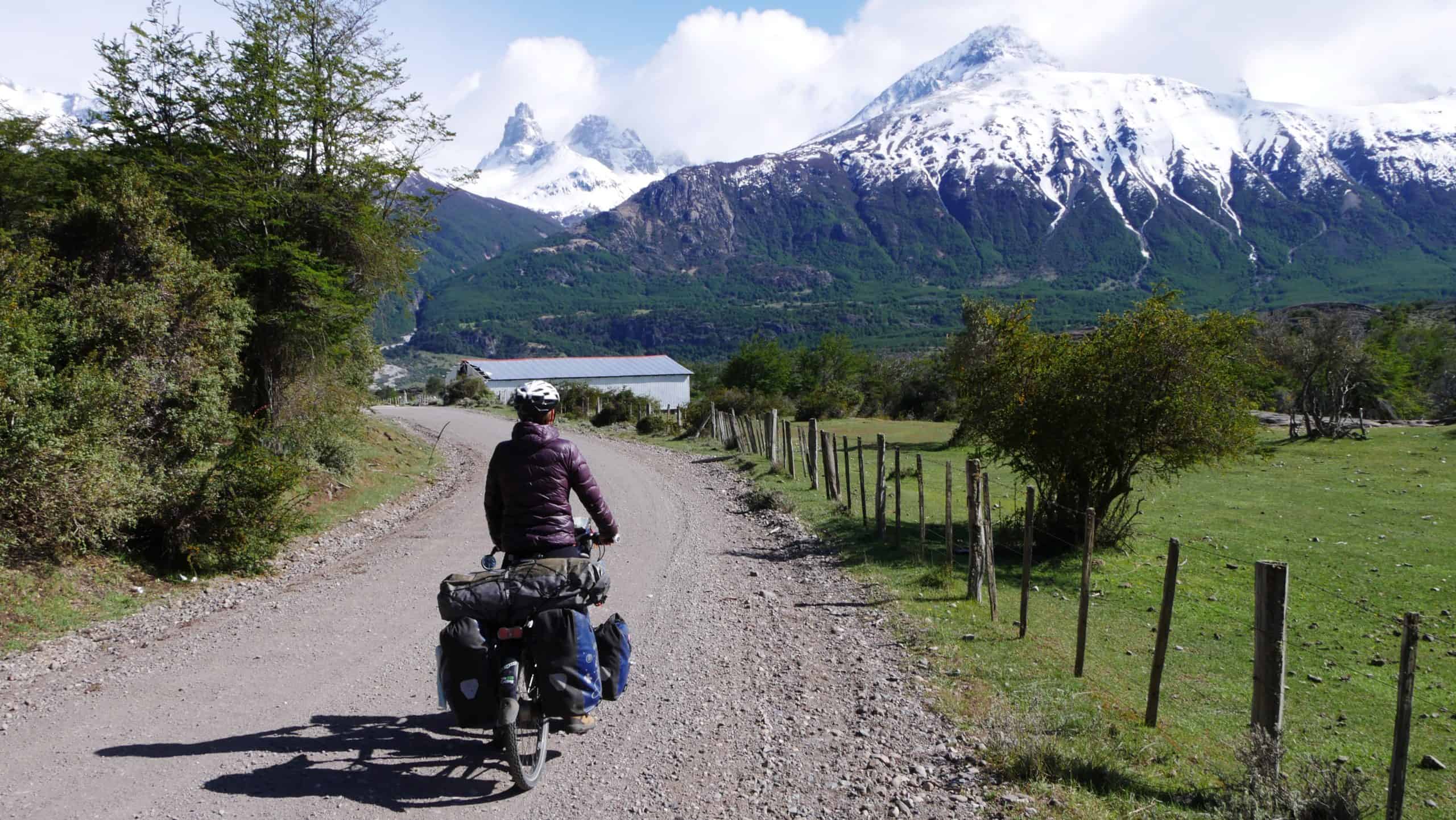
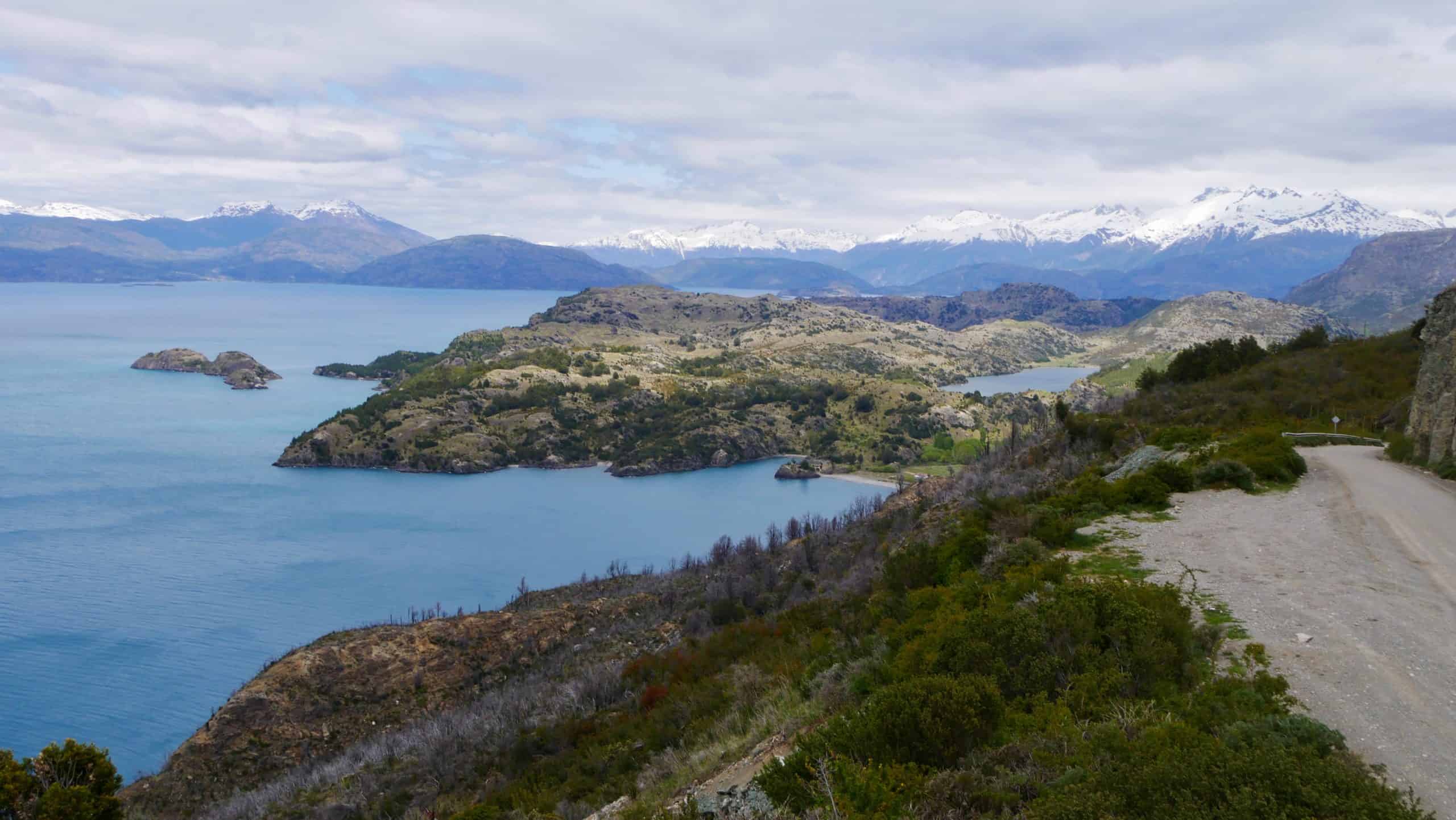
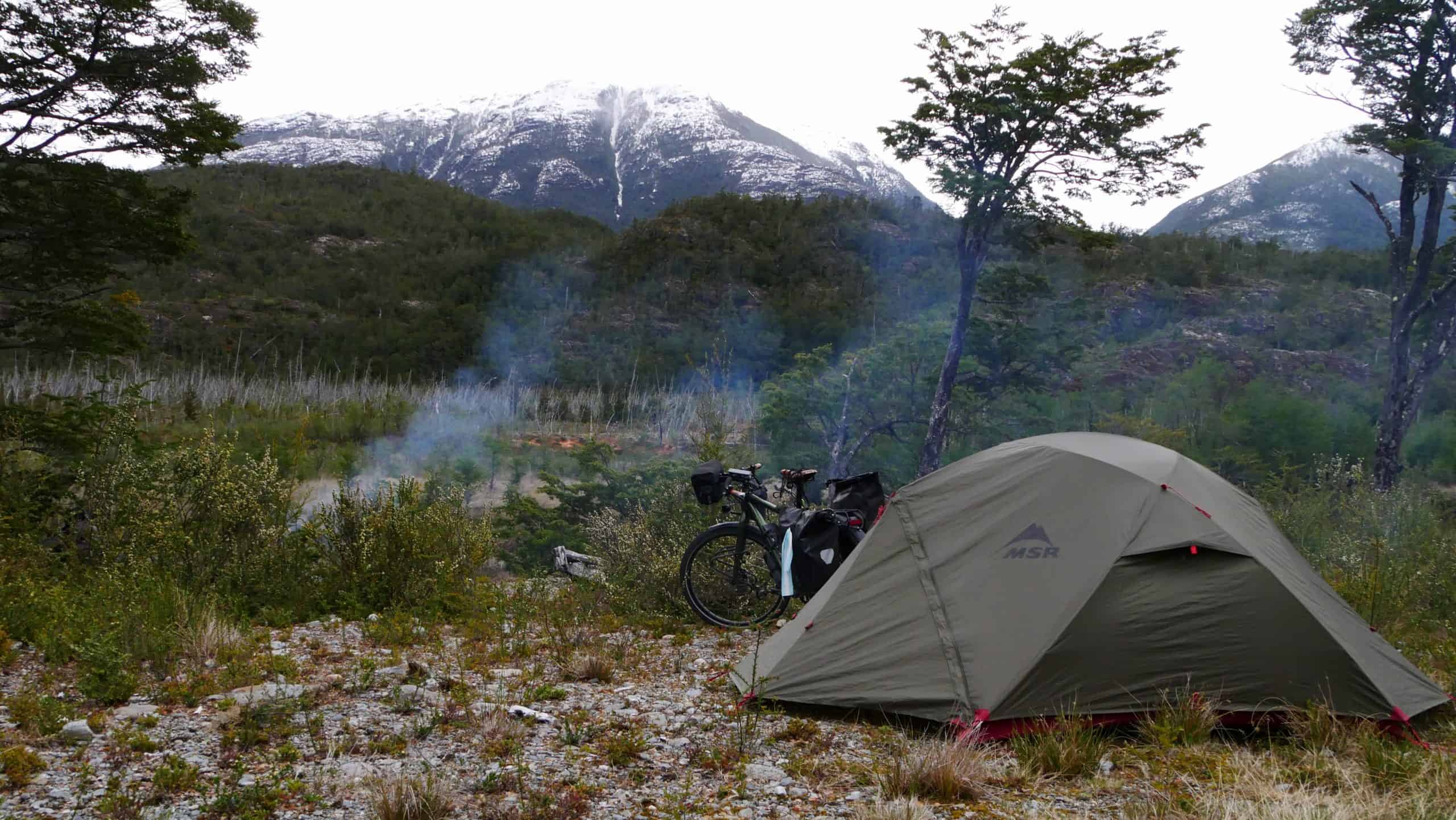
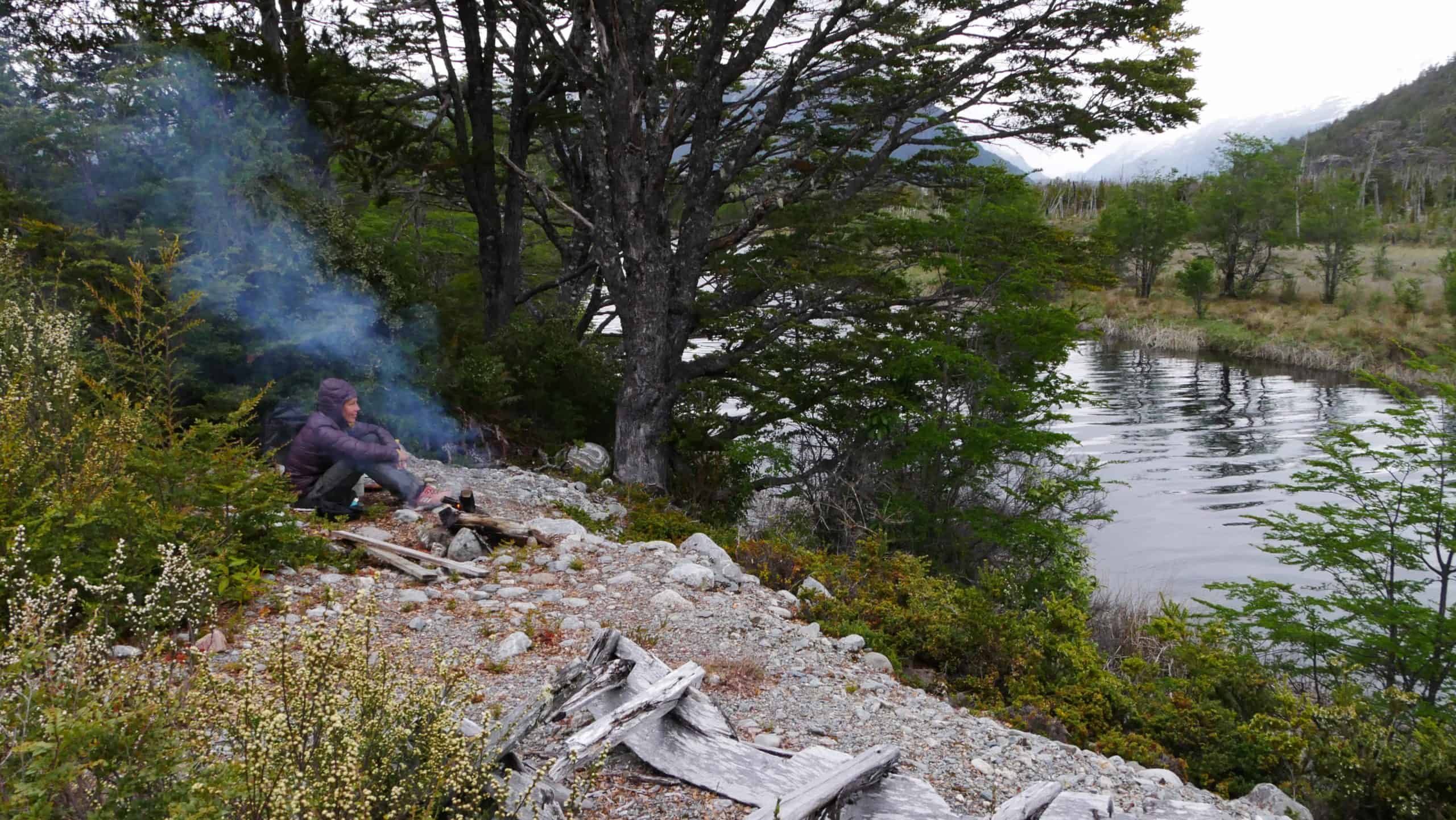
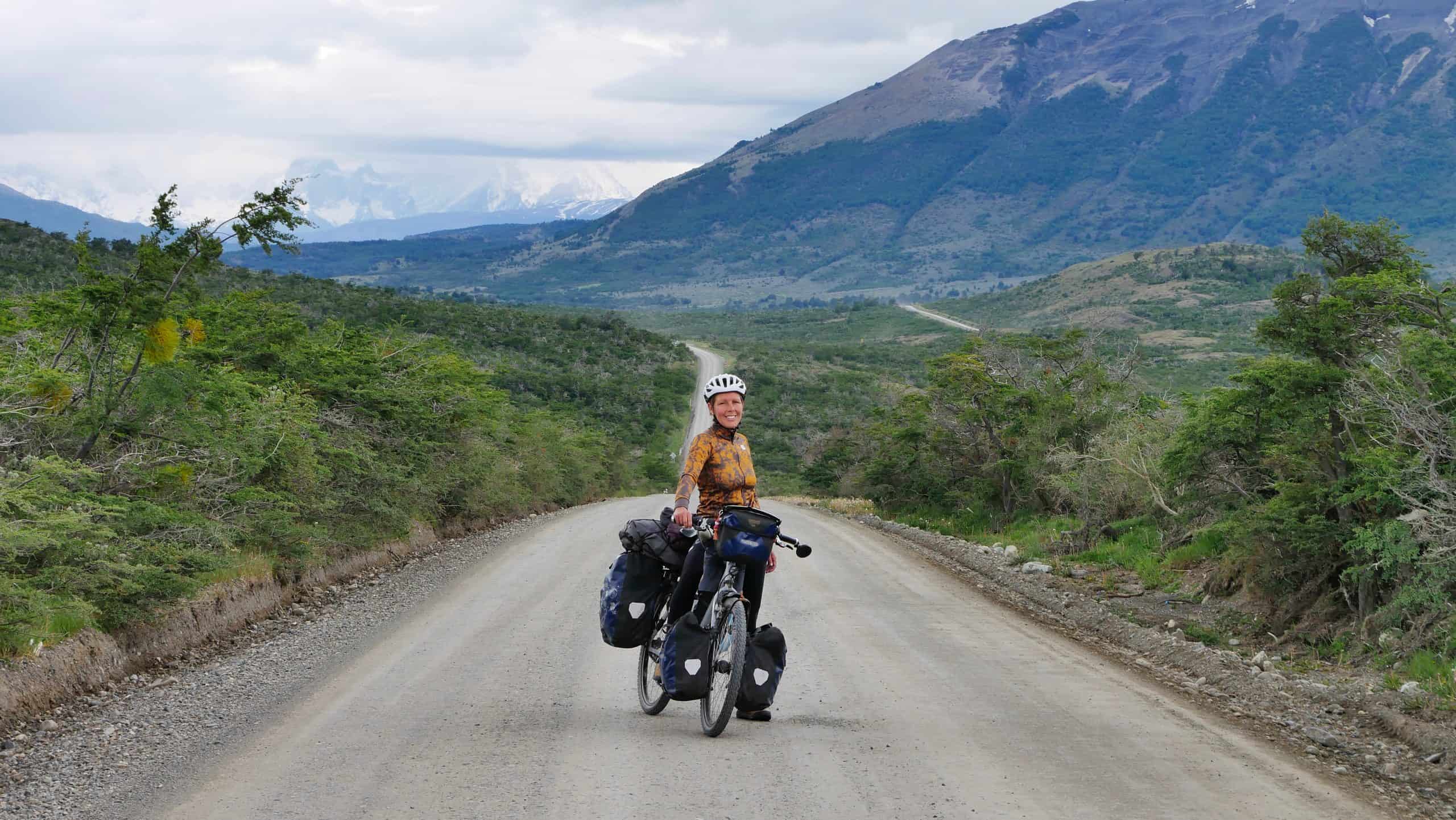
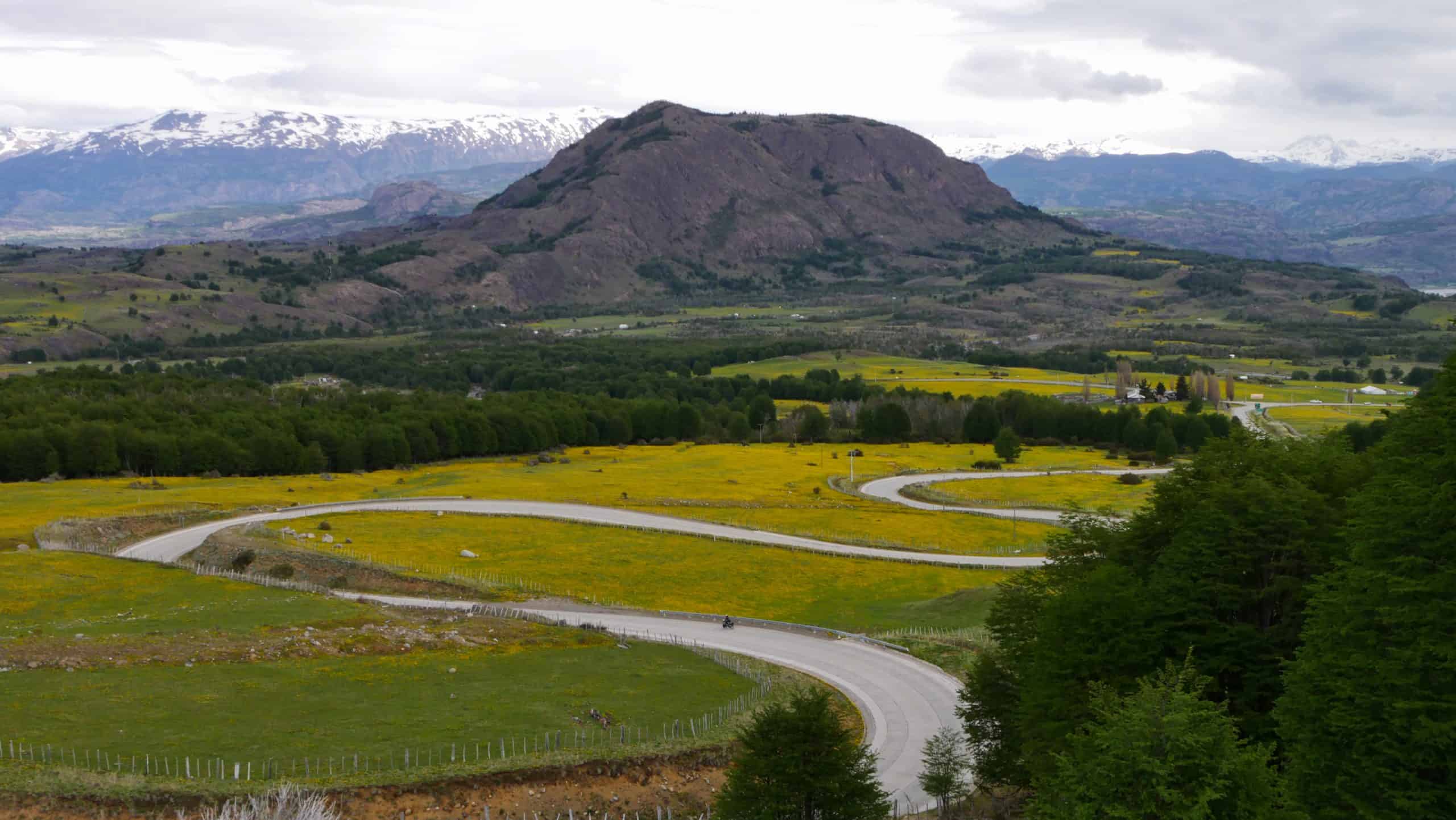
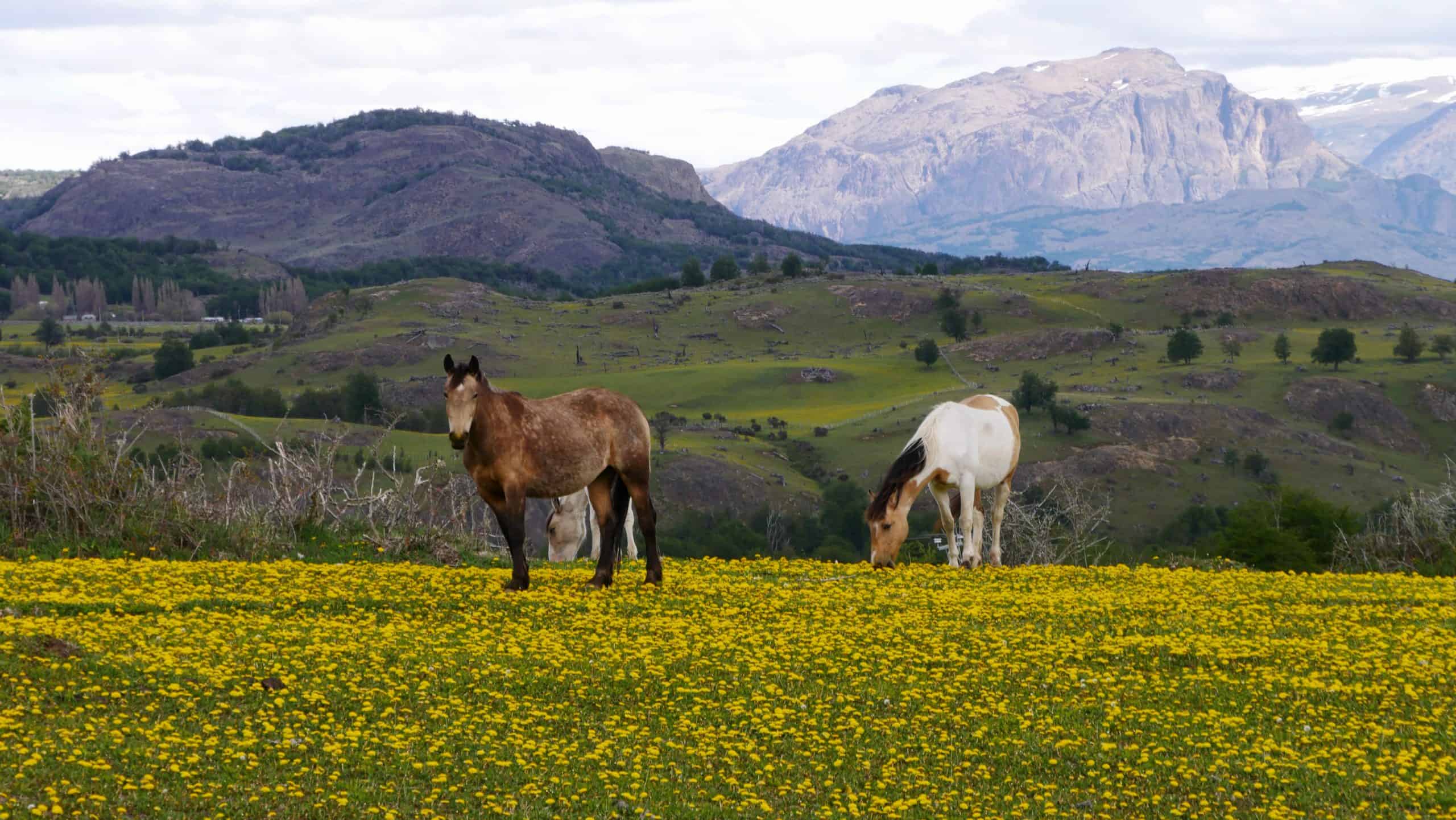
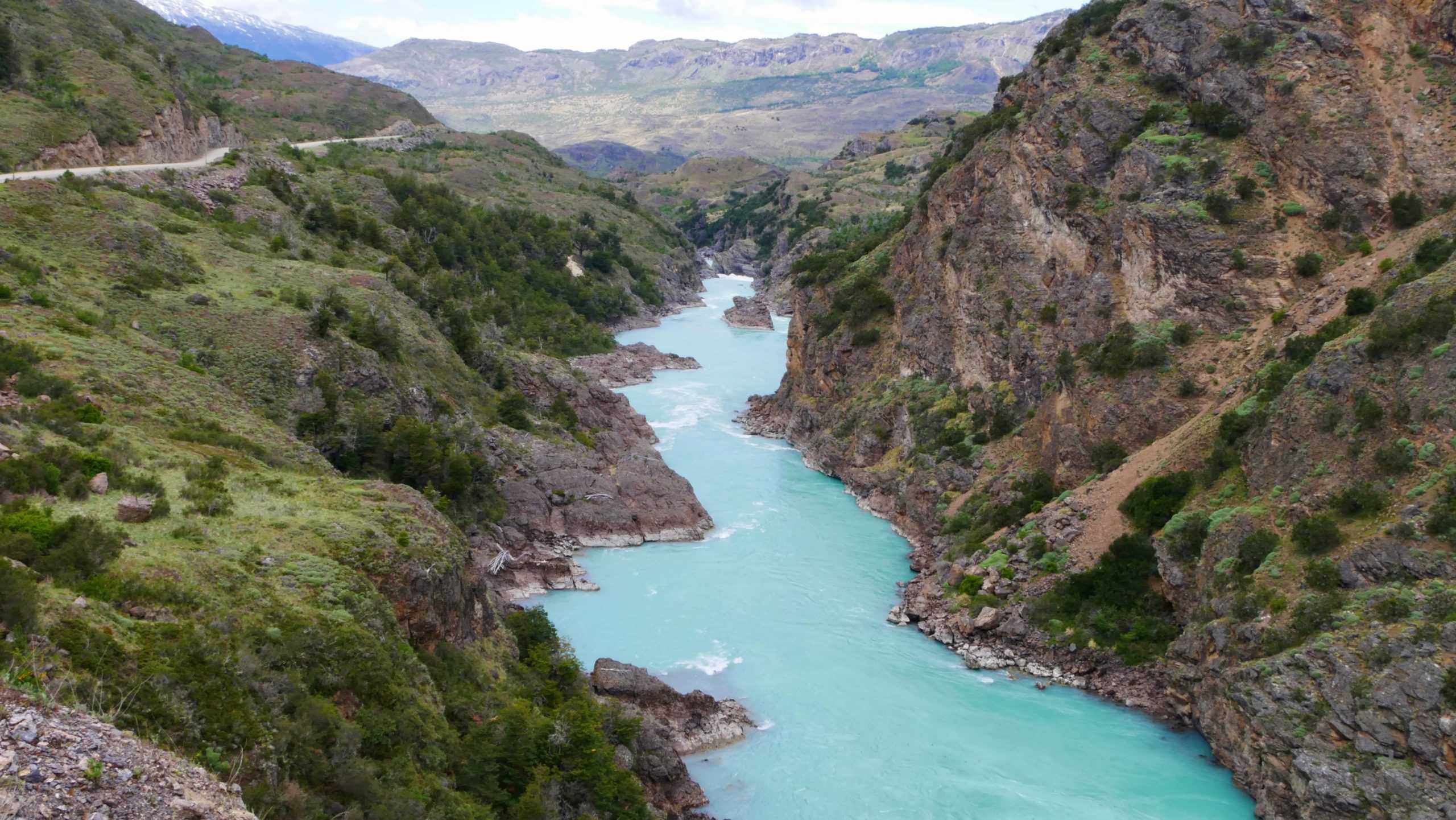
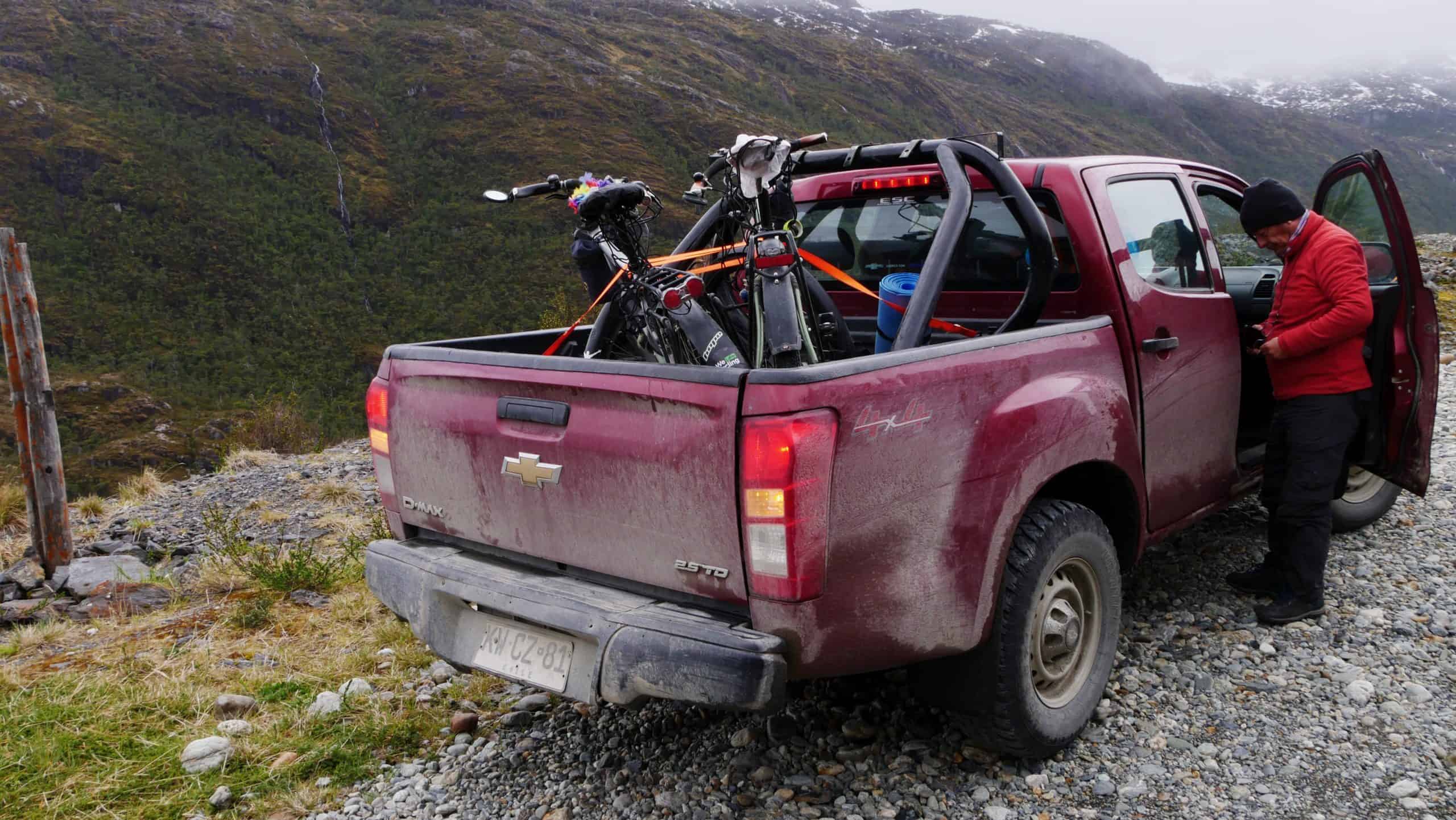
After a good night’s sleep, a short-term plan and a massage of the muscles around my knee, I feel much better the next morning. Alternating between bicycle and pickup truck, we continue on our way. But the further south we get, the sparser the traffic. One steep climb that we had intended to hitchhike we are thus forced to cycle anyway. Fortunately my knee feels okay and I am thoroughly enjoying myself, with rain on my snout, as I climb at snail’s pace through an arctic rainforest. Moss and plants hang dripping along the rock walls and around every corner we see a new waterfall. Cycling here without rain would actually do the environment a disservice! On the other side of the pass we descend to Puerto Yungai where we arrive just in time to take the ferry across the lake. In the waiting room/refugio on the other side we spend the night in a sheltered place.
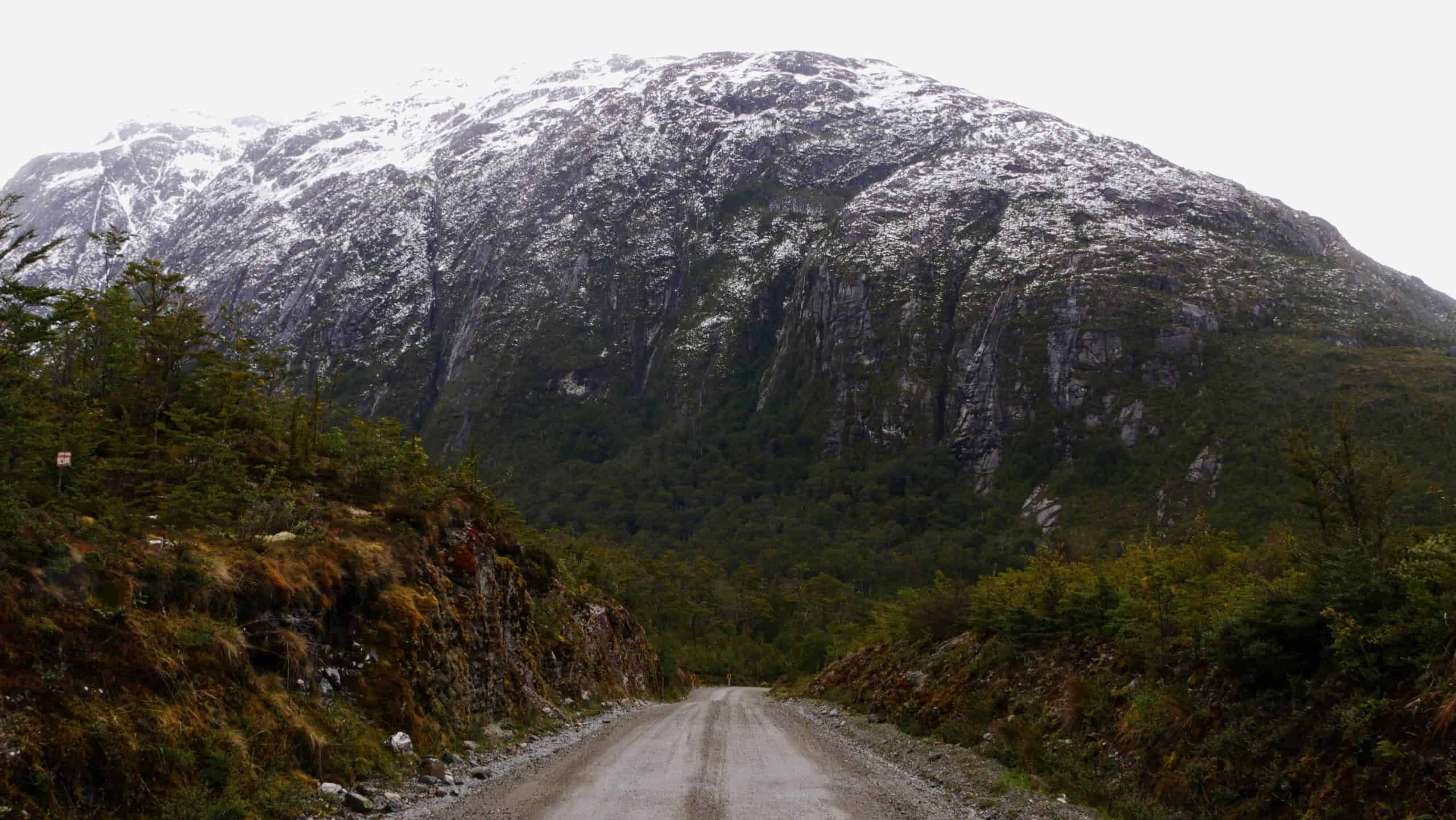
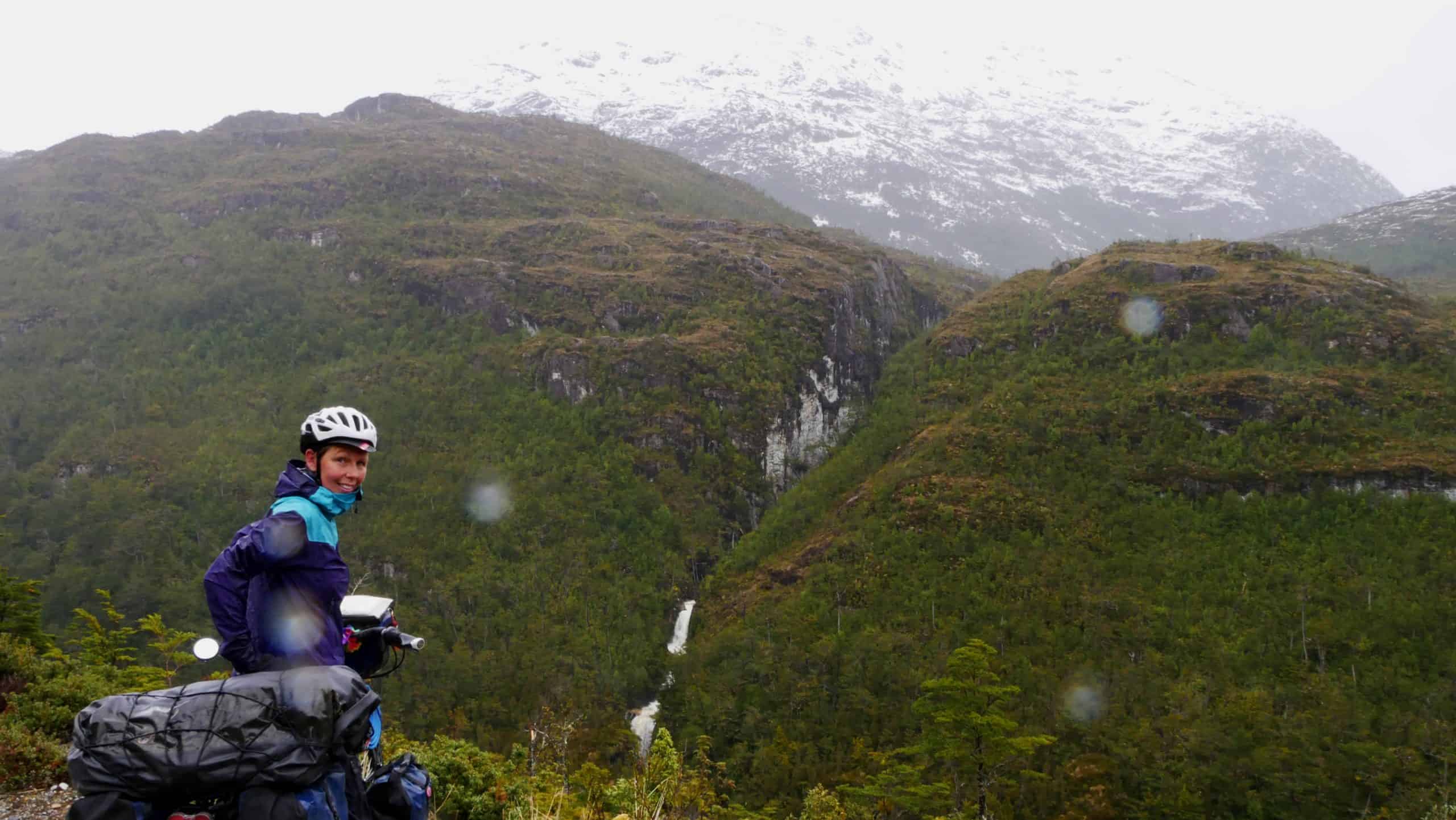
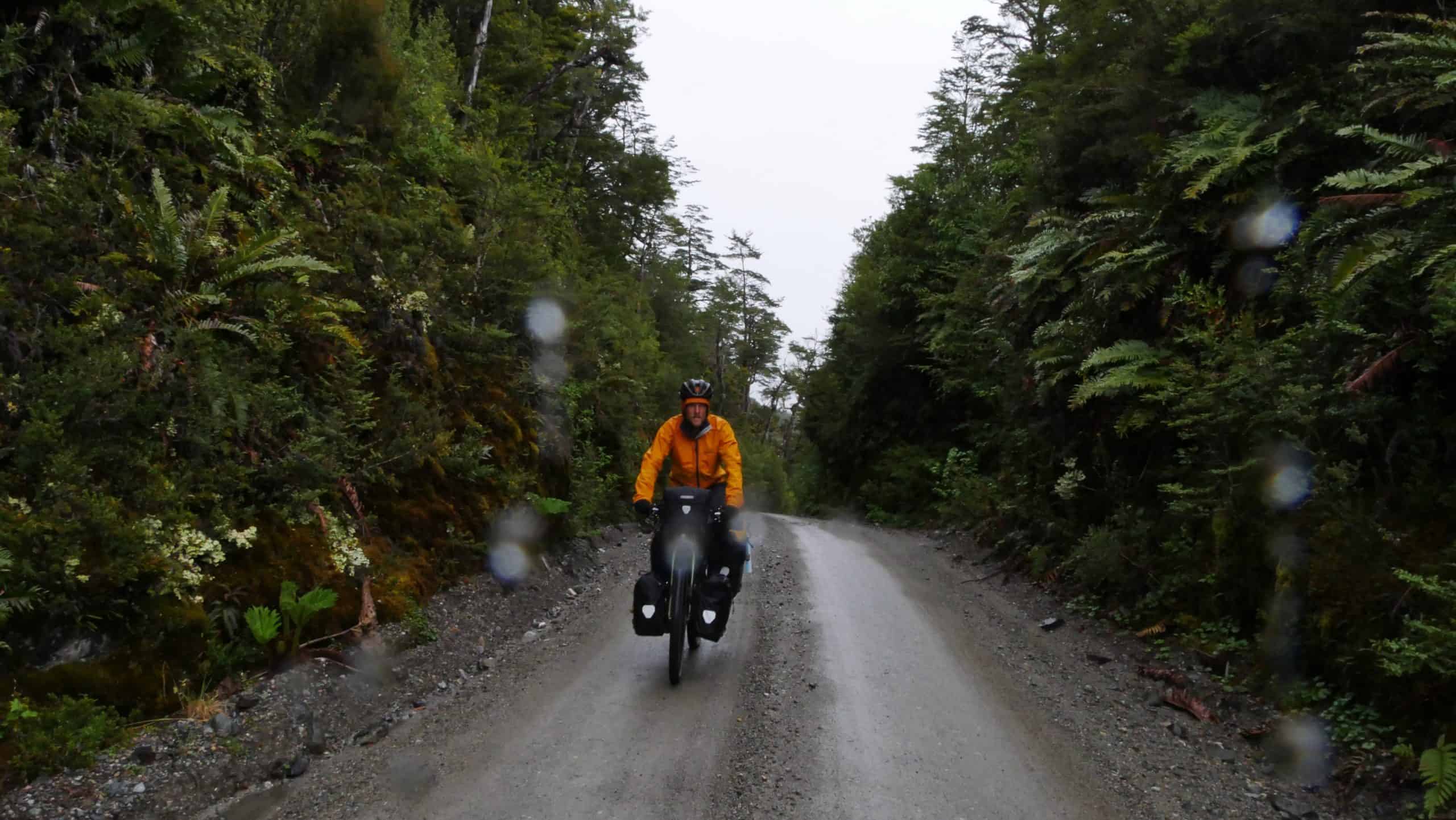
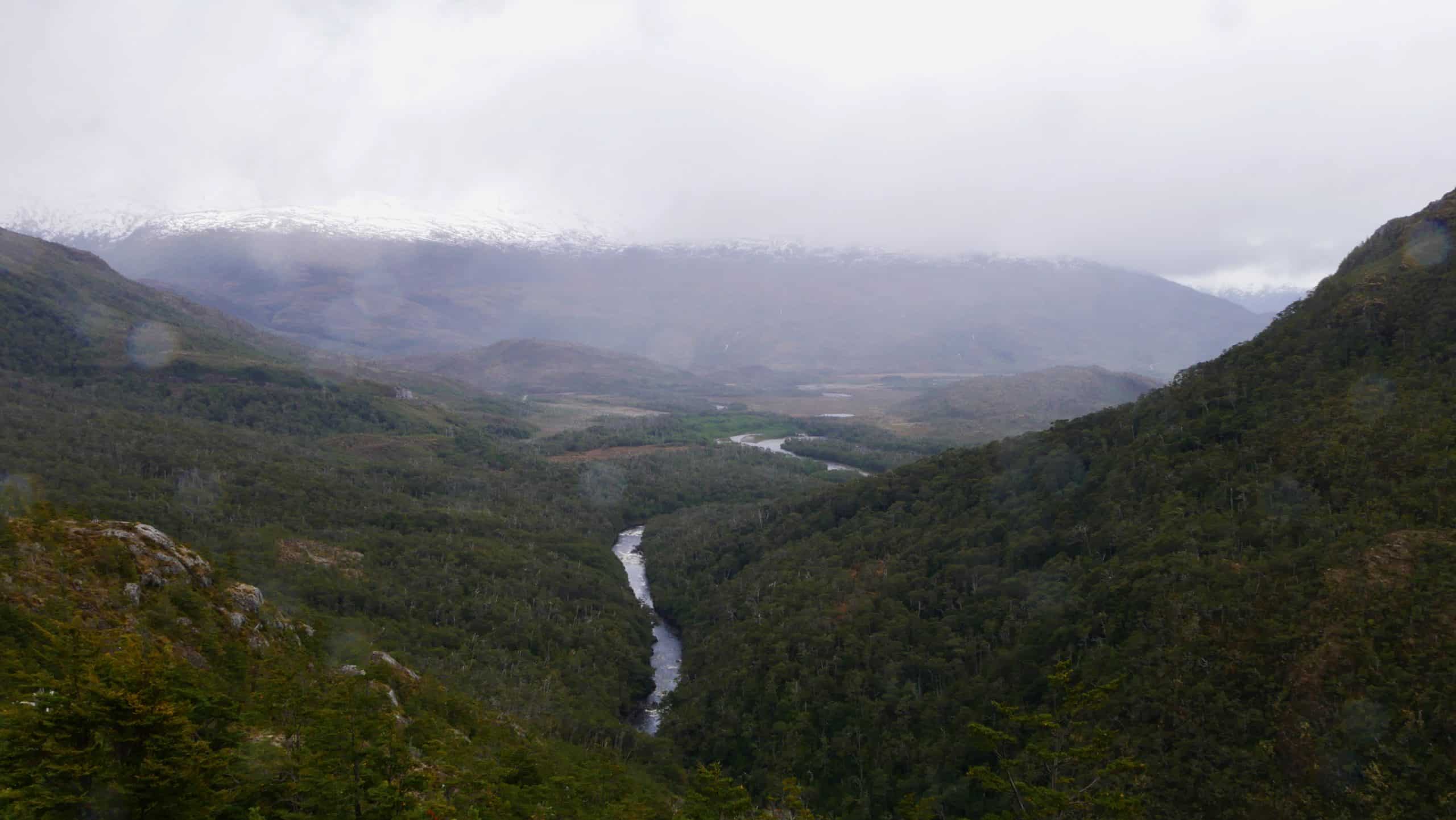
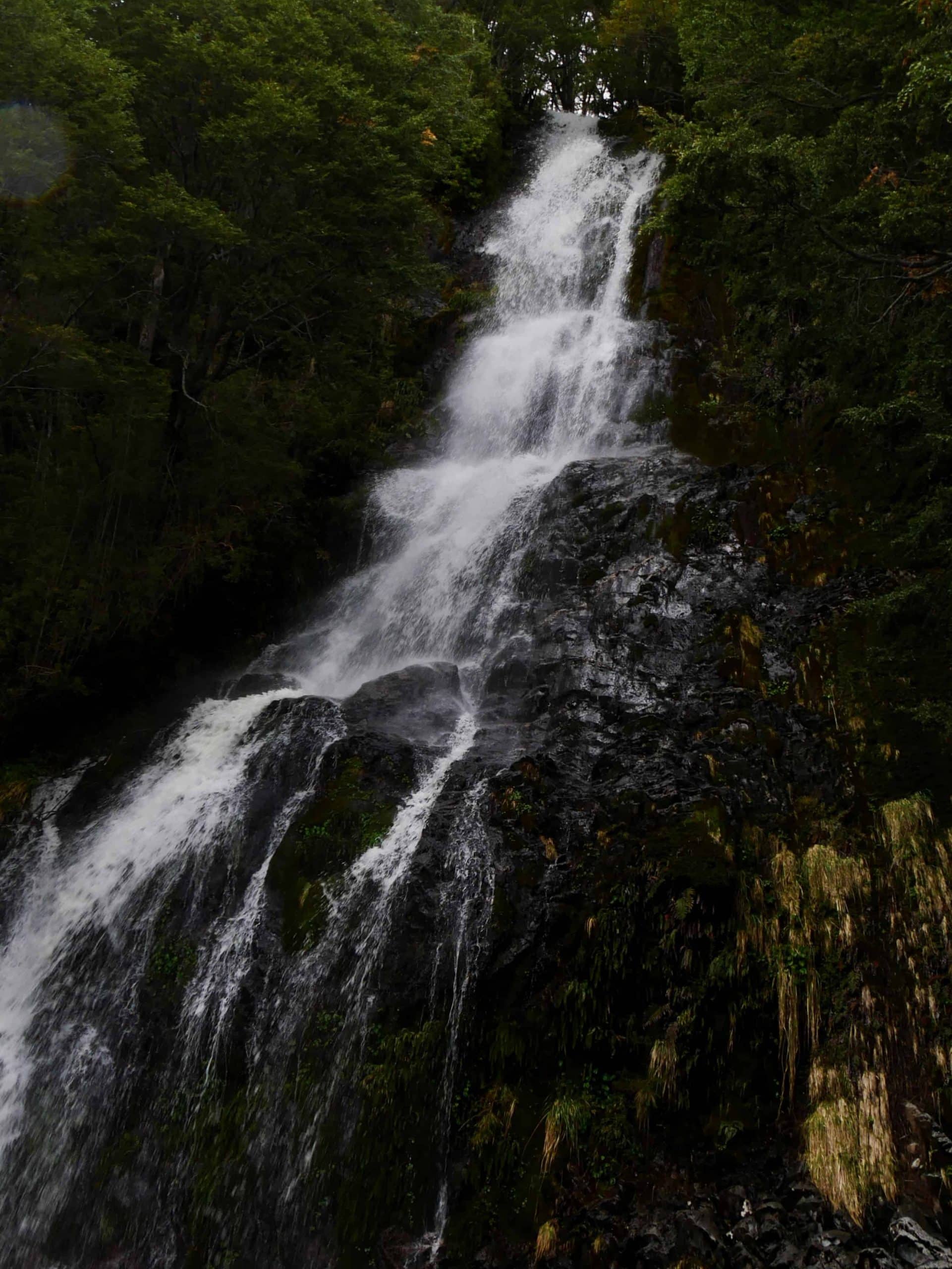
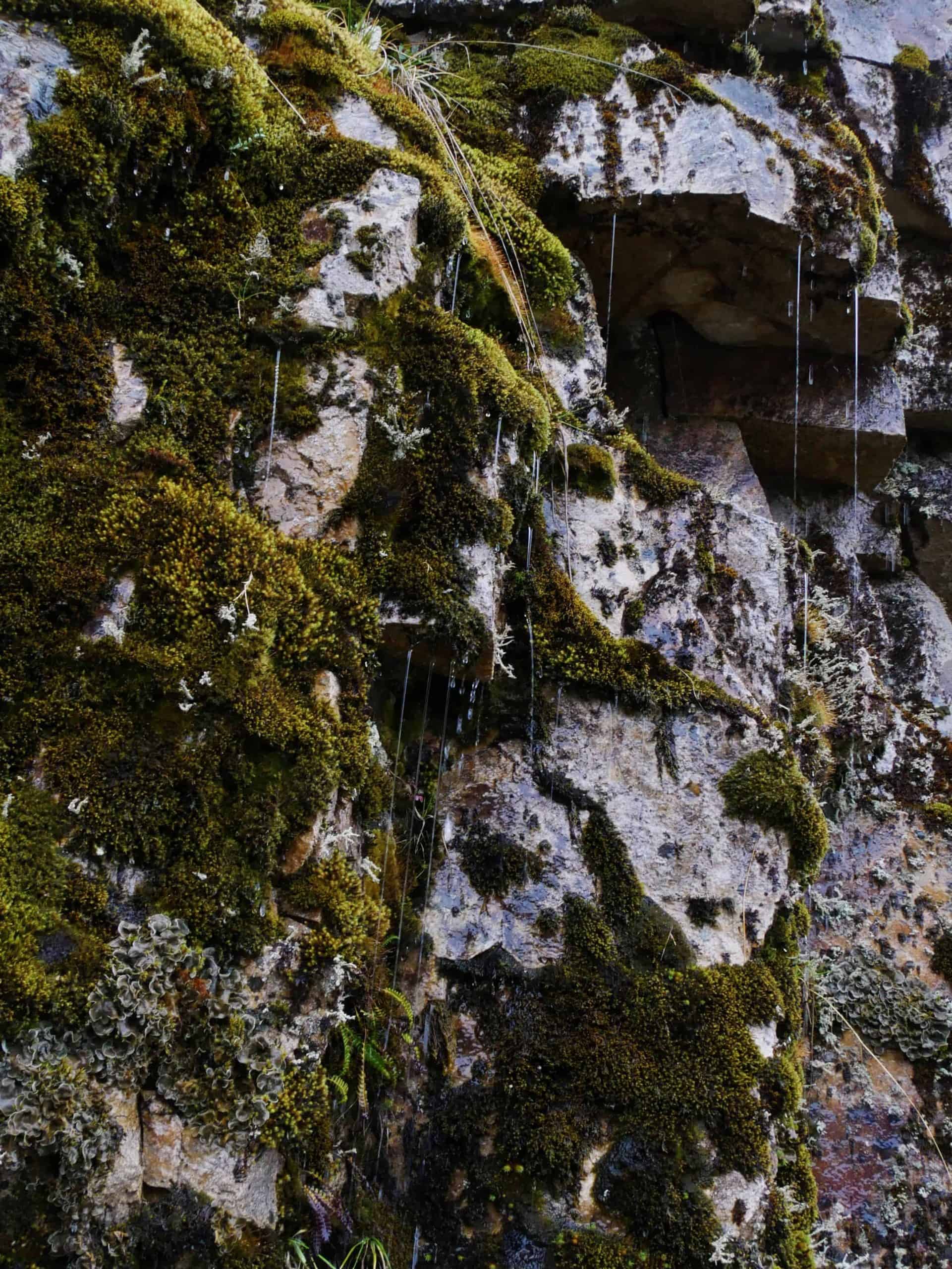


The next morning we have an immediate prize when the first ferry docks. Two local tourists in a pickup truck find no problem giving us a ride to the only next village, Villa o’ Higgins, which marks the end of the Carretera Austral. Yet we prefer to get off halfway along that route, at an old wooden hut set up for bicycle travelers to take shelter. There is a fireplace and some wood. The walls are full of greetings and slogans from other bicycle travelers and the instruction to always leave some wood behind for the next visitors. We decide to spend the rest of the day here and one last day tomorrow cycling in this beautiful area.
So a rest day in a remote cabin in the wilderness. Waiting for it to stop raining is no use. We put on our rain gear and go in search of more wood. Once the fire is going we dry the large pieces of wood next to it. Close to the fire (the room itself doesn’t really heat up) we play a few games of Claim (a card game we have with us). For once, I win most of the games! In the evening, just as we are about to eat, a young man invades the cabin. Soaked and dripping with water, despite his plastic festival poncho. Moments later, his girlfriend enters as well. Argentinian Nahuel and his girlfriend cycled 55km on this rainy day against the strong wind from Villa o’ Higgins. A little embarrassed that we have been sitting here all day chilling after an elevator up the mountain, we clear our spot close to the fire for them. As Paul and I look at their gear, the festival ponchos, the soggy sneakers and the way-too-thin sleeping bags, we realize once again how very lucky we are to have our high-quality gear. We “rich Dutchmen. They ride the same tough route as we do, with the hefty challenge of inadequate equipment added to it. We admire them!
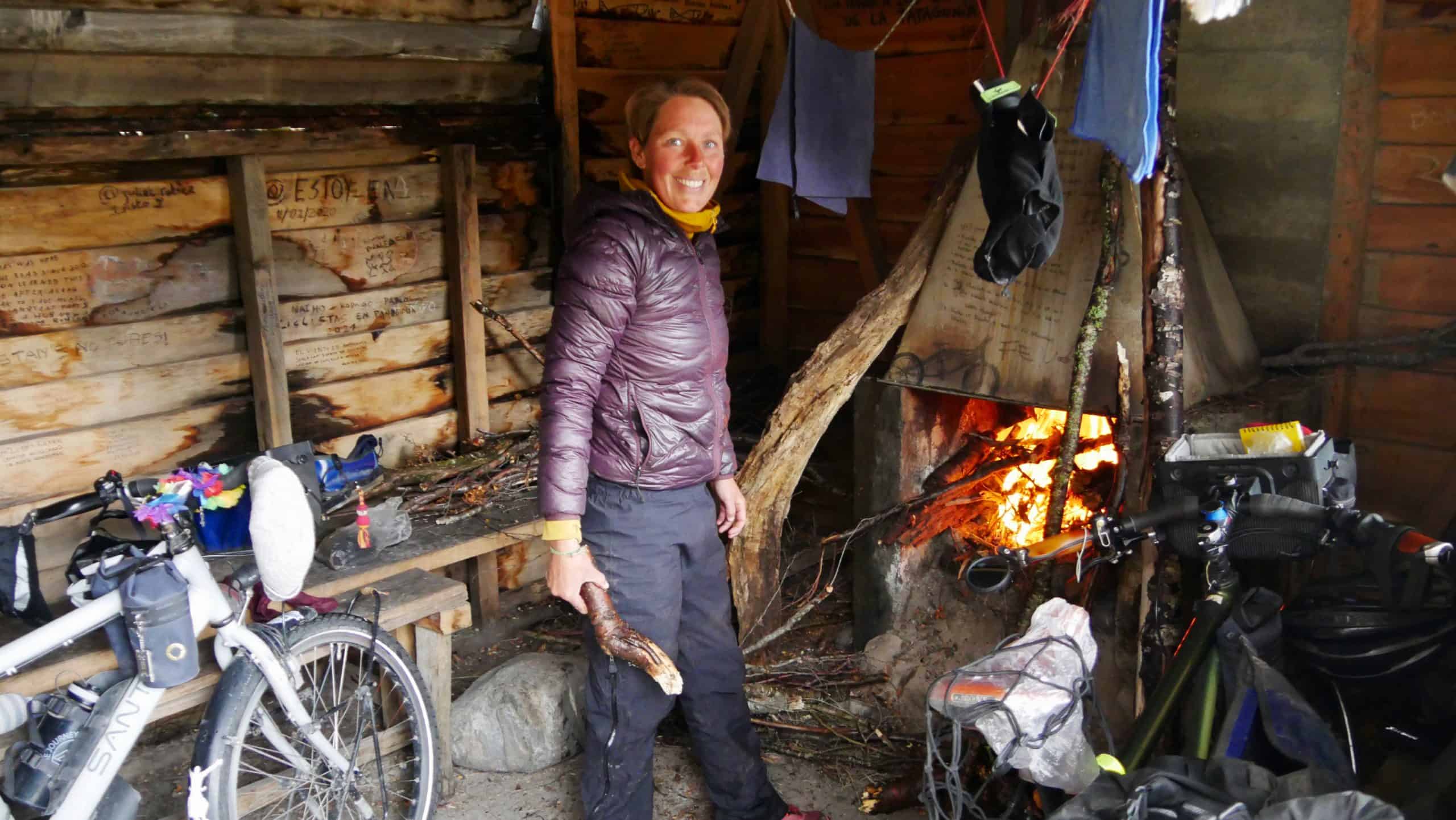

The next day, dry and with our backs to the wind, we ride to Villa o’ Higgins. From here, car or motorcycle riders can only turn around. Cyclists and hikers can continue by boat. At a small office in the village we reserve a place on the boat that will leave two days later. At least that is the intention, because boats are canceled here all the time because of weather conditions that are too bad. We camp at a campsite with a warm communal sitting area and kitchen. The only bread we can buy in this remote place is sweet soft factory bread for 5 euros. We eat that in one lunch! For the same money, I would rather buy a bag of whole wheat flour. I bake three nutritious tasty loaves which we put in our panniers. Two days later we are ready on the dock at 7:00 in the morning. About what awaits us we have already heard many a story….
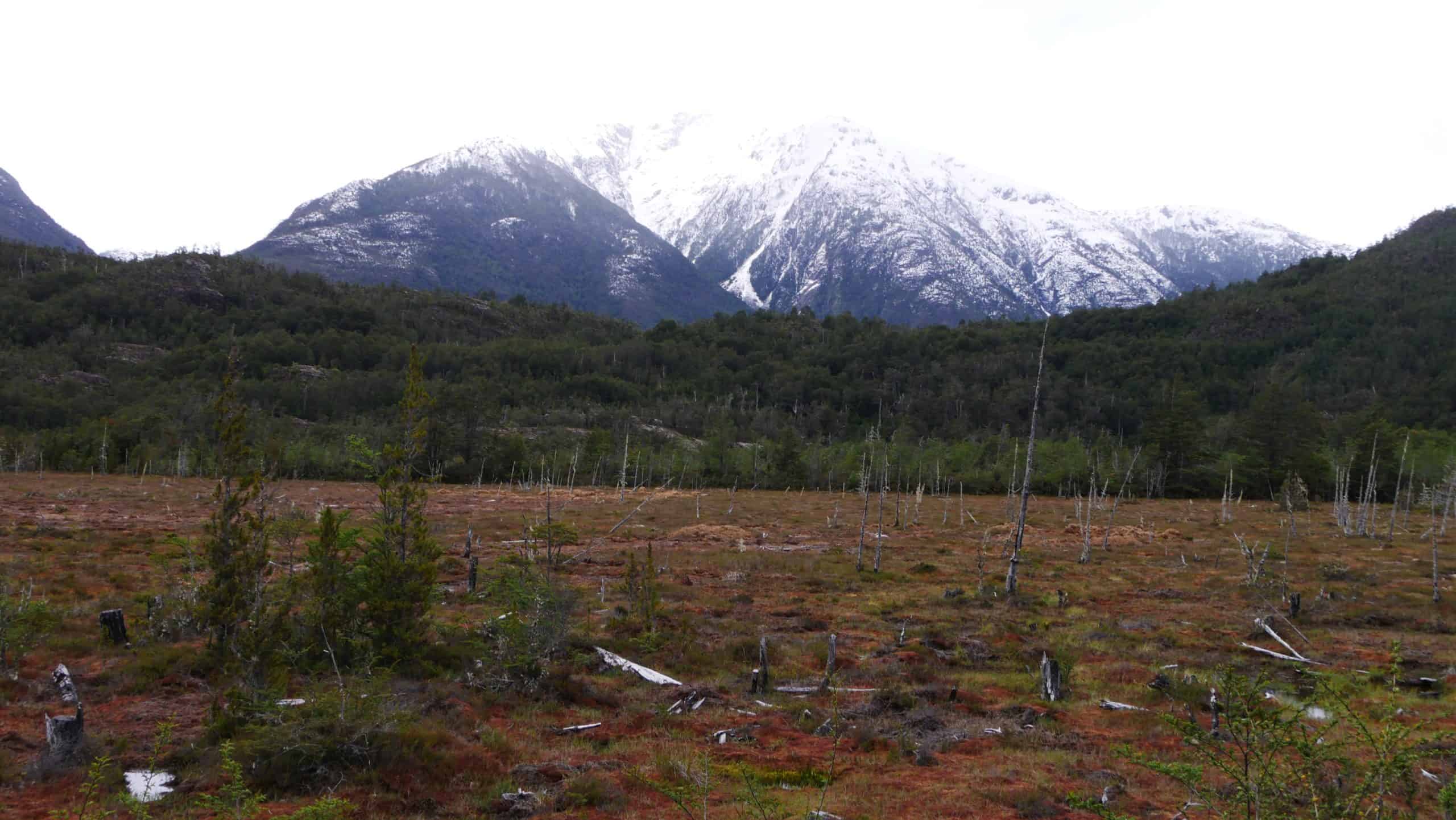

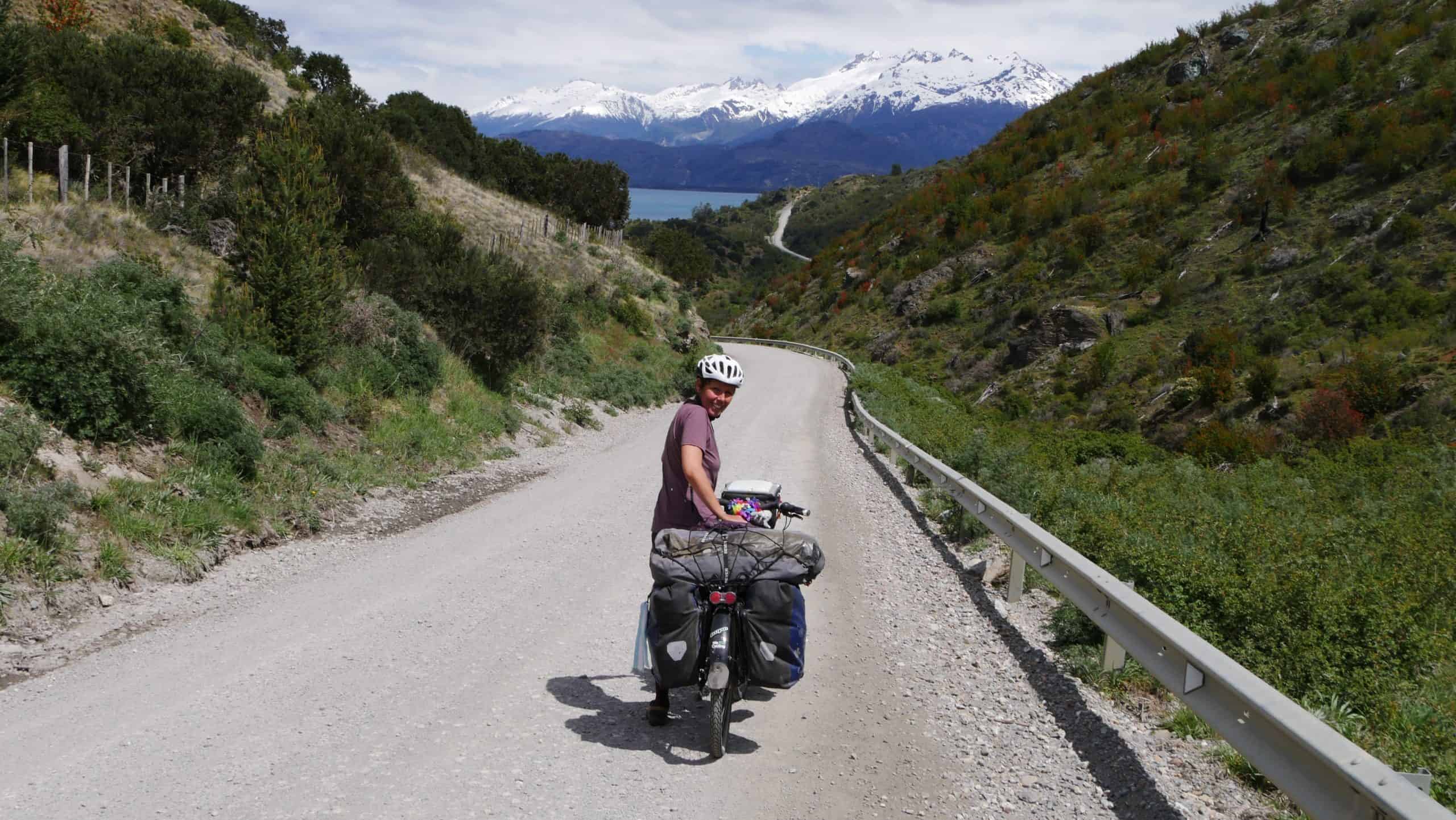
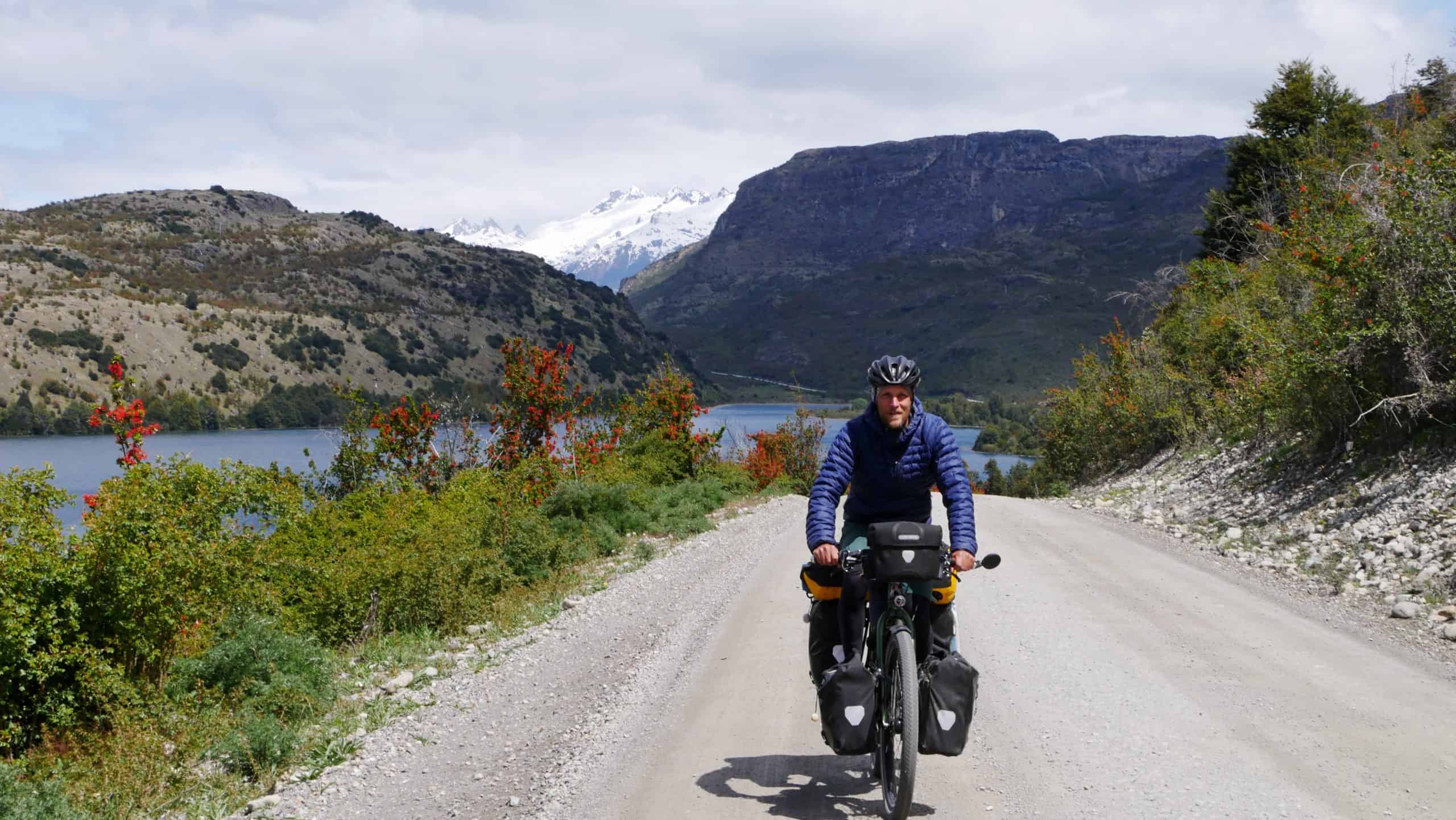
With seven other cyclists and two backpackers together, we board. Our bikes and bags fill the small aft deck. Inside there is room for about 16 people. In two hours we cross Lago o’ Higgins. A lake that forms the border between Chile and Argentina. On the other side the Chilean customs post awaits us and 20 km further on the Argentine customs post. These 20 km consist for 15 km of a gravel road uphill and for 5 km of a narrow path through the woods with finally a steep descent to Lago Desierto in Argentina.
When a challenge is in front of me I like to sink my teeth into it and so I start with full force. Paul, I and German Darius, who has been biking from Canada to Ushuaia for a year and a half, are the heaviest of the group. Nevertheless, we soon form the vanguard and decide to cover the route with the three of us. Because of the departure time of the next boat that day, across Lago Desierto, we have limited time: 7 hours for the 20-kilometer stretch. Sounds ample, right?
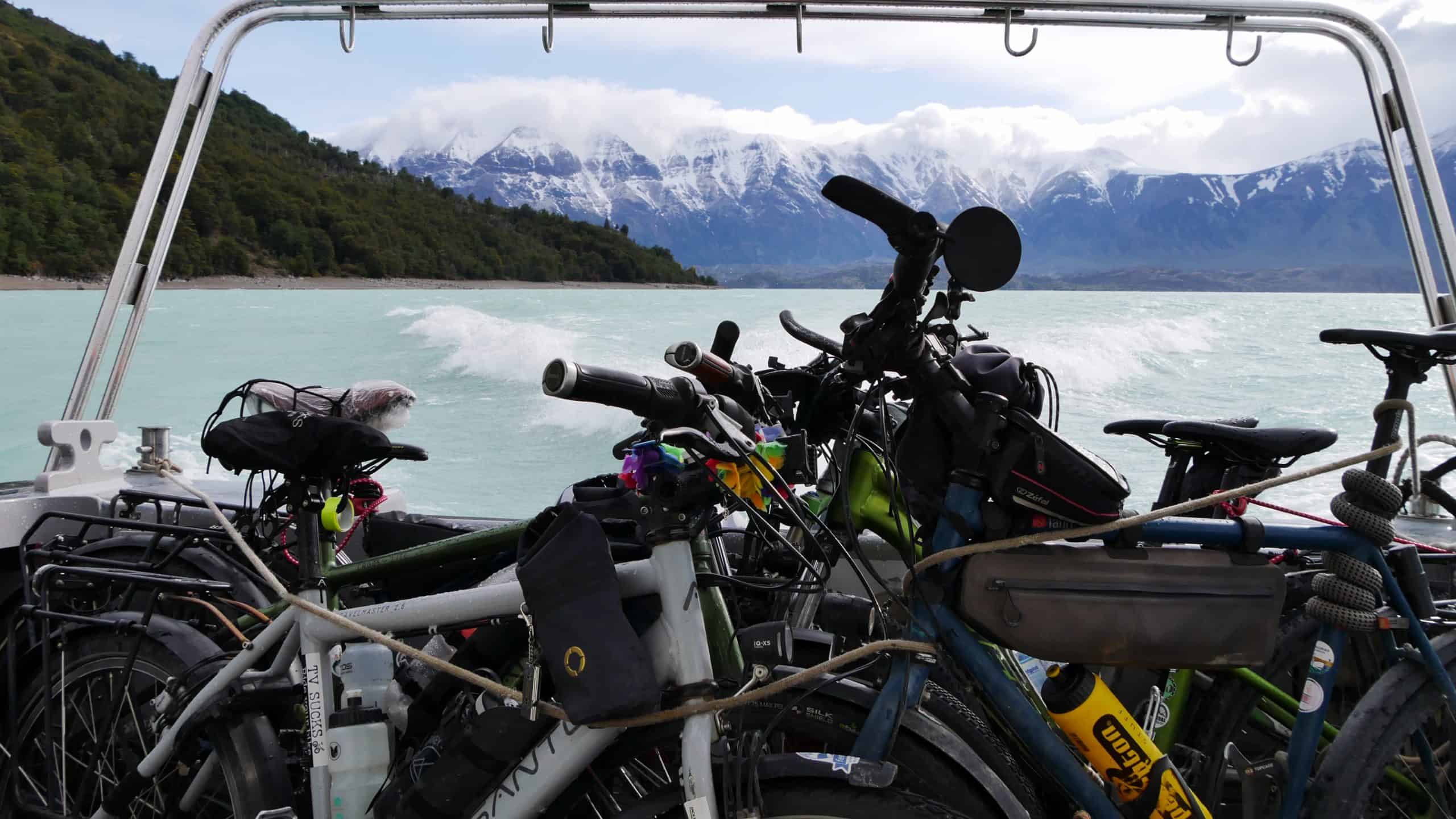
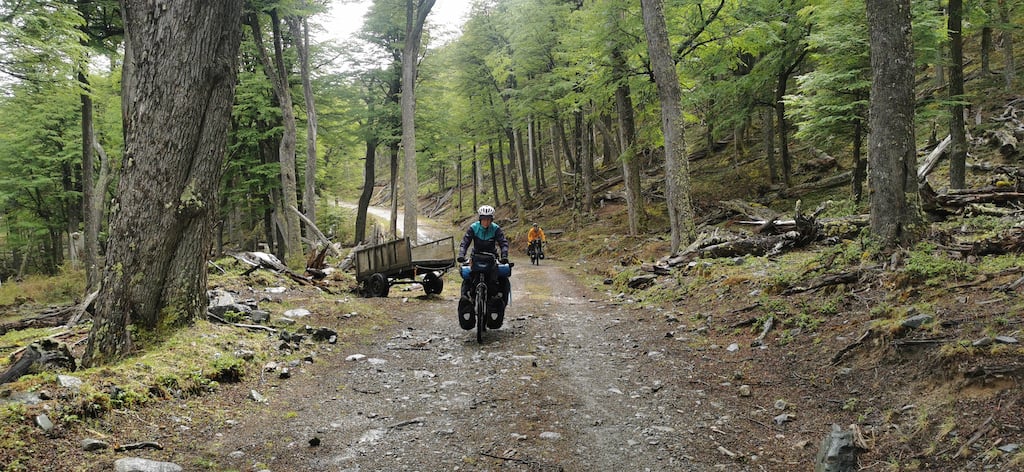
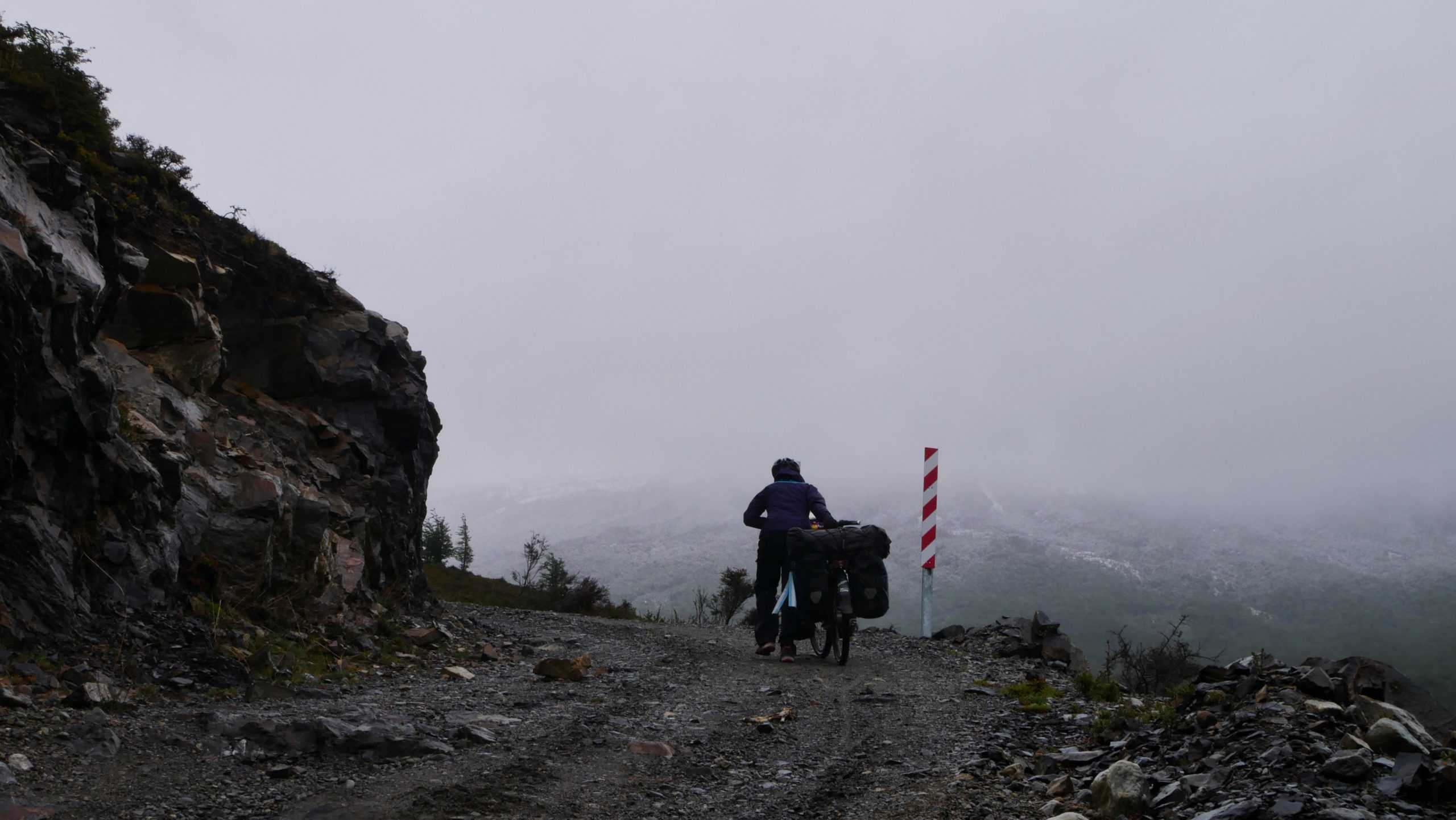
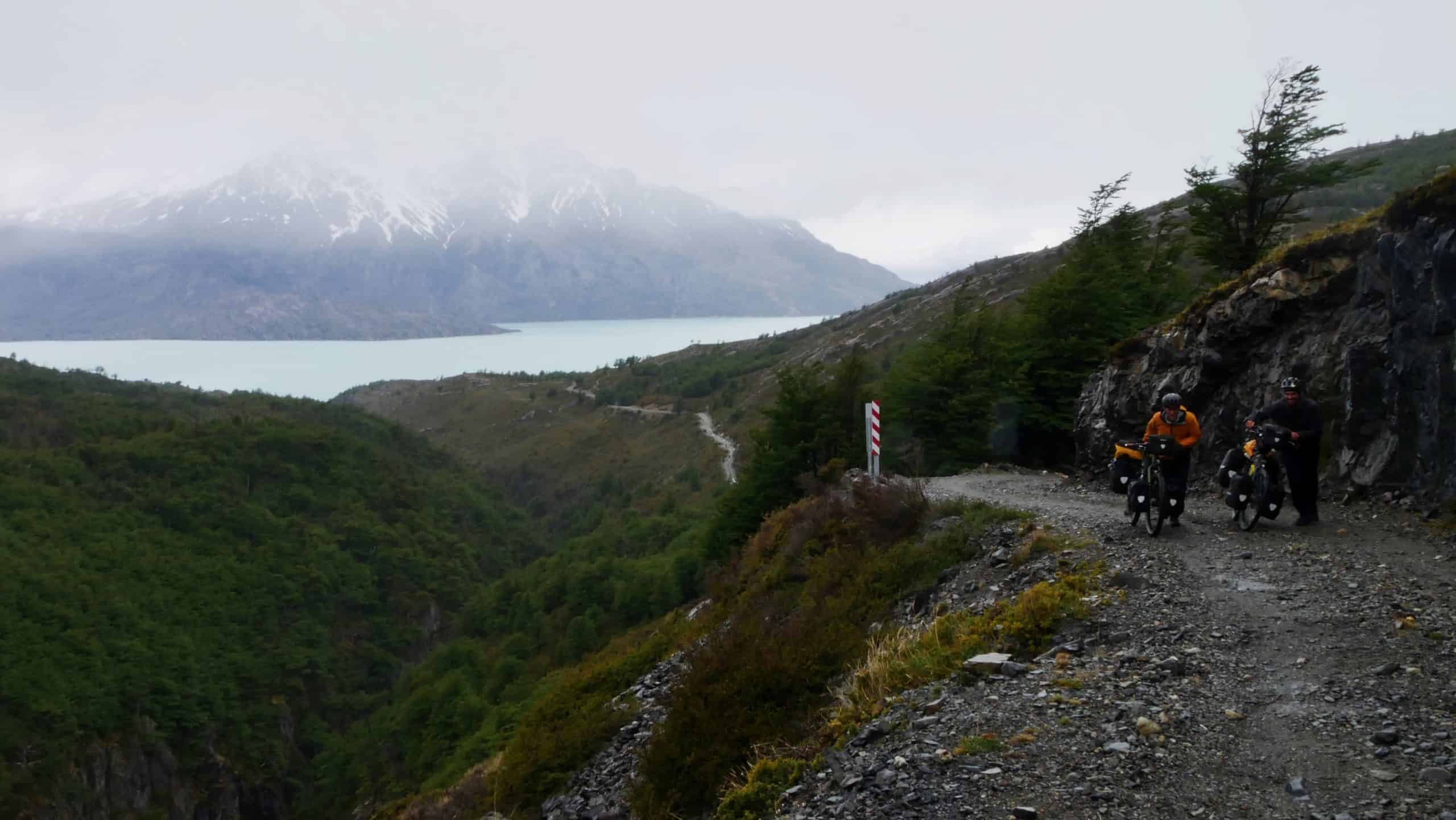
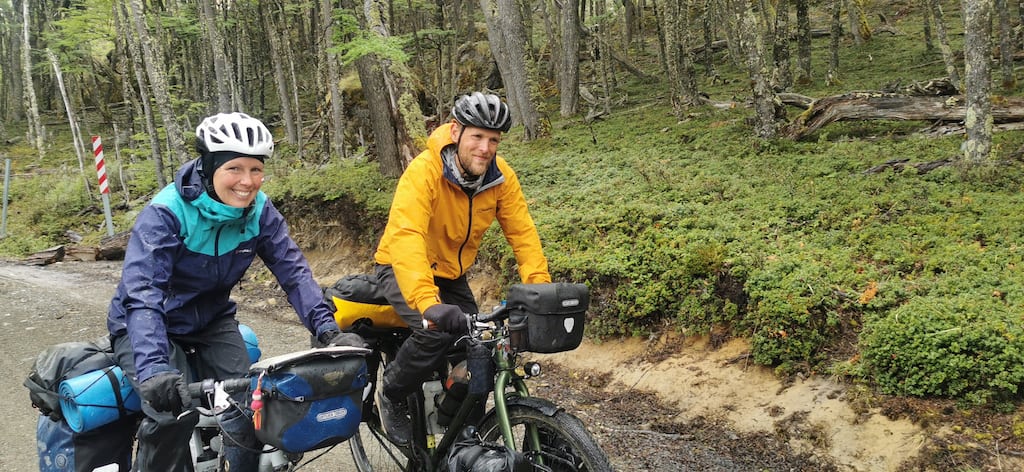
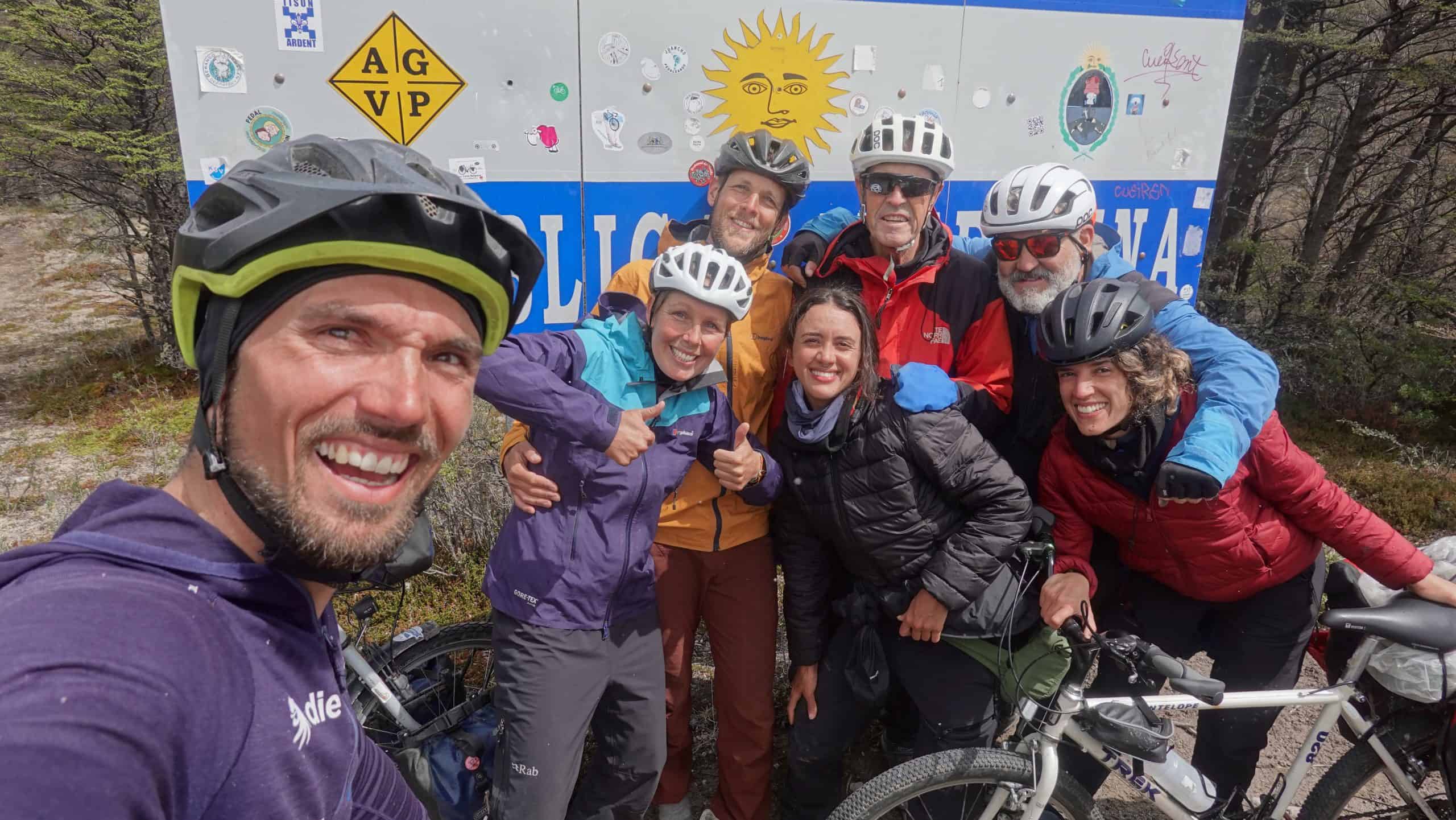
At snail’s pace we pedal and push the first 15km uphill until we reach the sign welcoming us to Argentina. Here we also meet the other cyclists who caught up with us during our lunch break. Right here the gravel road stops and a narrow path through the forest begins. It is no wider than a donkey trail and the only reason it is not completely overgrown is that two but a few adventurers pass over here five months a year. There seems to be no other reason for this unlikely border crossing to exist. For a moment we can start mountain biking, but soon enough even that is out of the question. We lift our bikes over tree trunks, balance on boulders in streams while guiding our bikes through them and help each other regularly to free the other from a predicament. While Paul maneuvers his bike across a stream via logs, I go through on my sandals with my bike. As we try to push our bikes up on the other side we both get stuck. Neither of us can leave without the bike then dropping in the water. I urge Darius, who is still dry and free on the other side, not to start crossing with his bike as well, because then all three of us would be stuck. That would be a awkward situation. We helps each other and the three of us finally cross the stream and climb the steep slope on the other side.
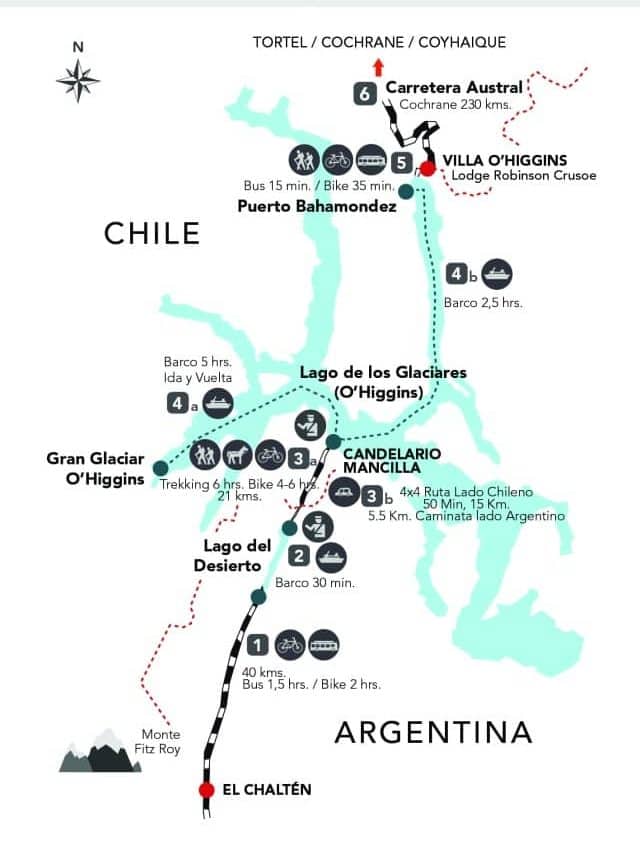
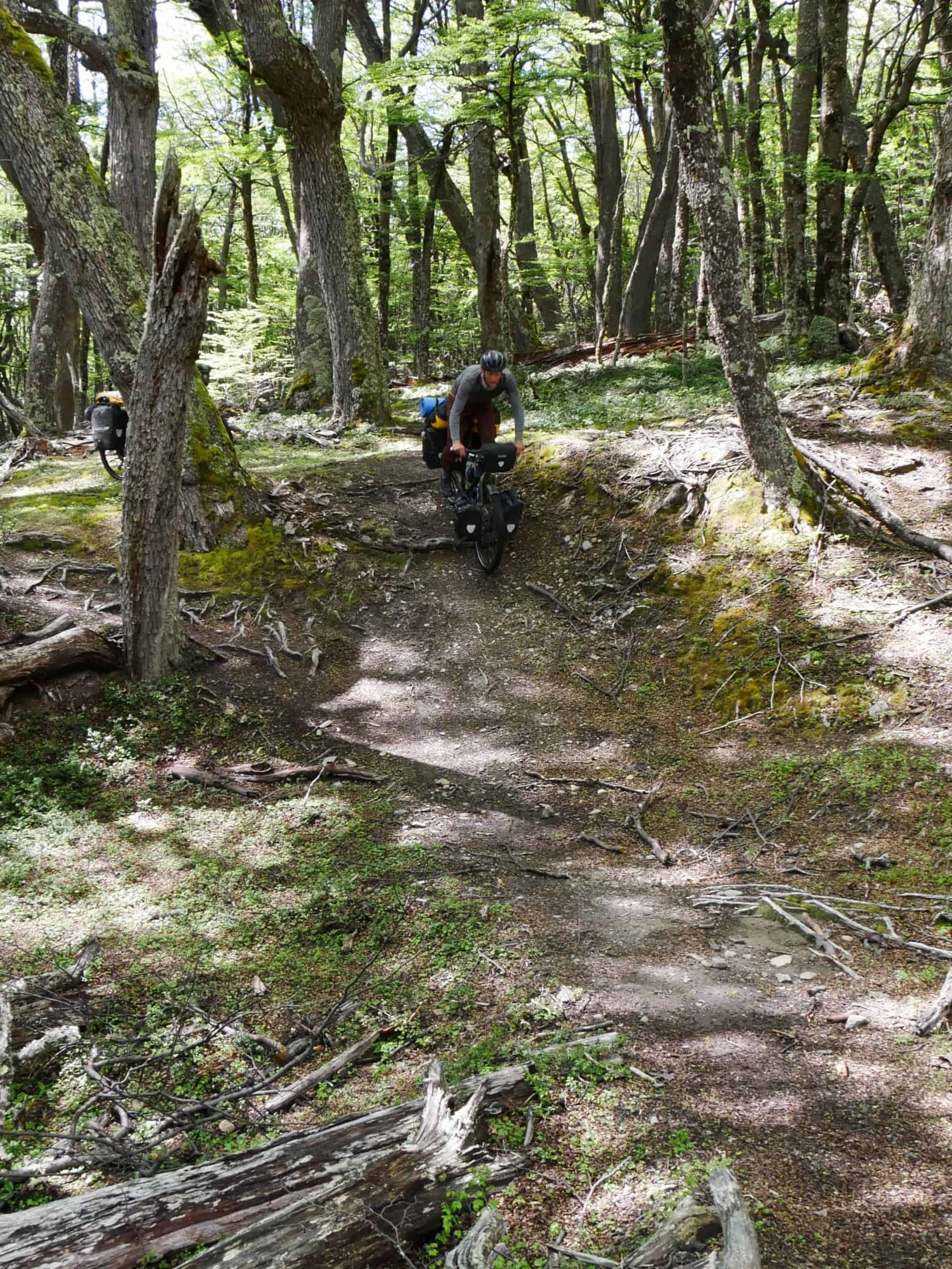
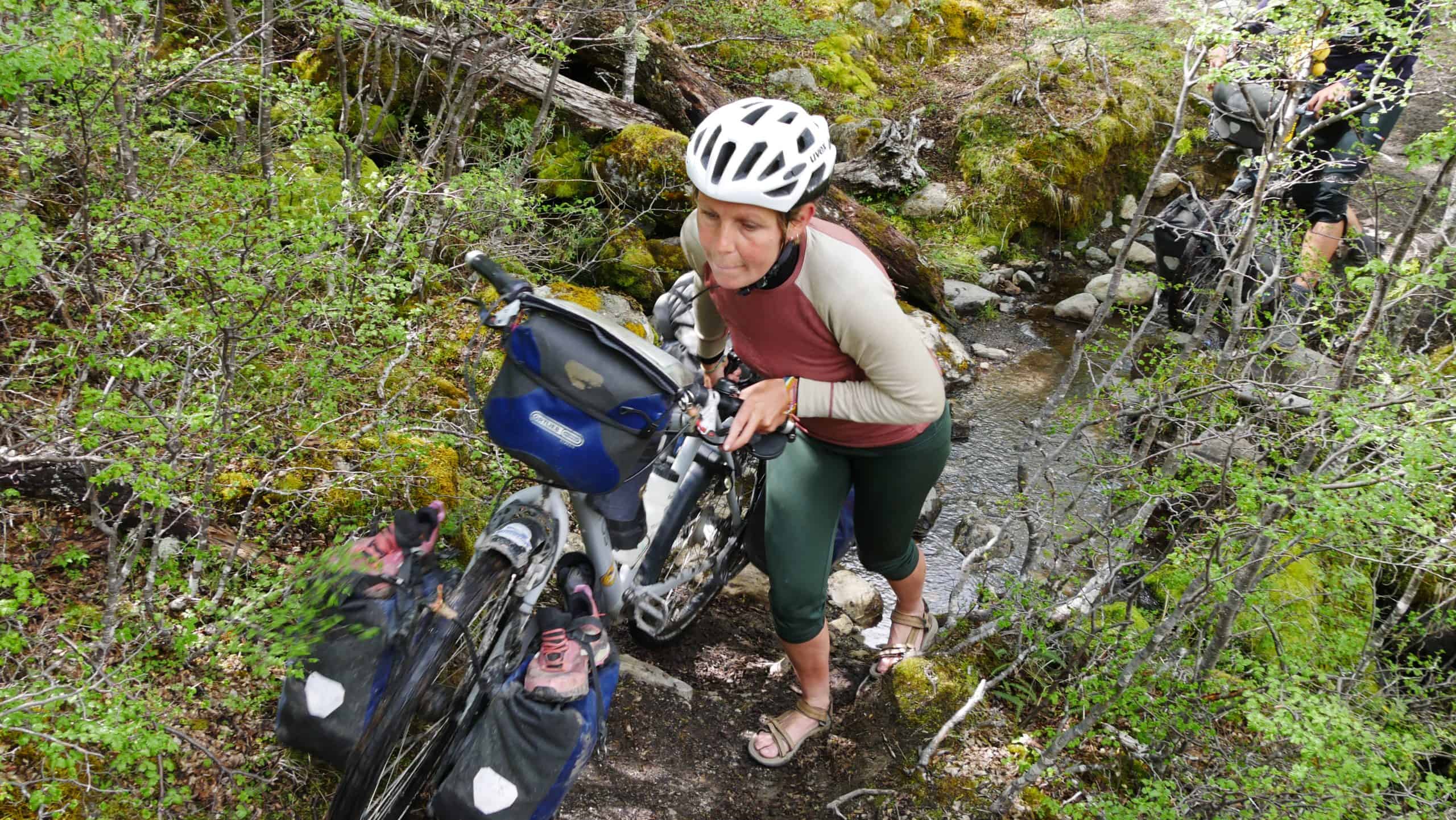
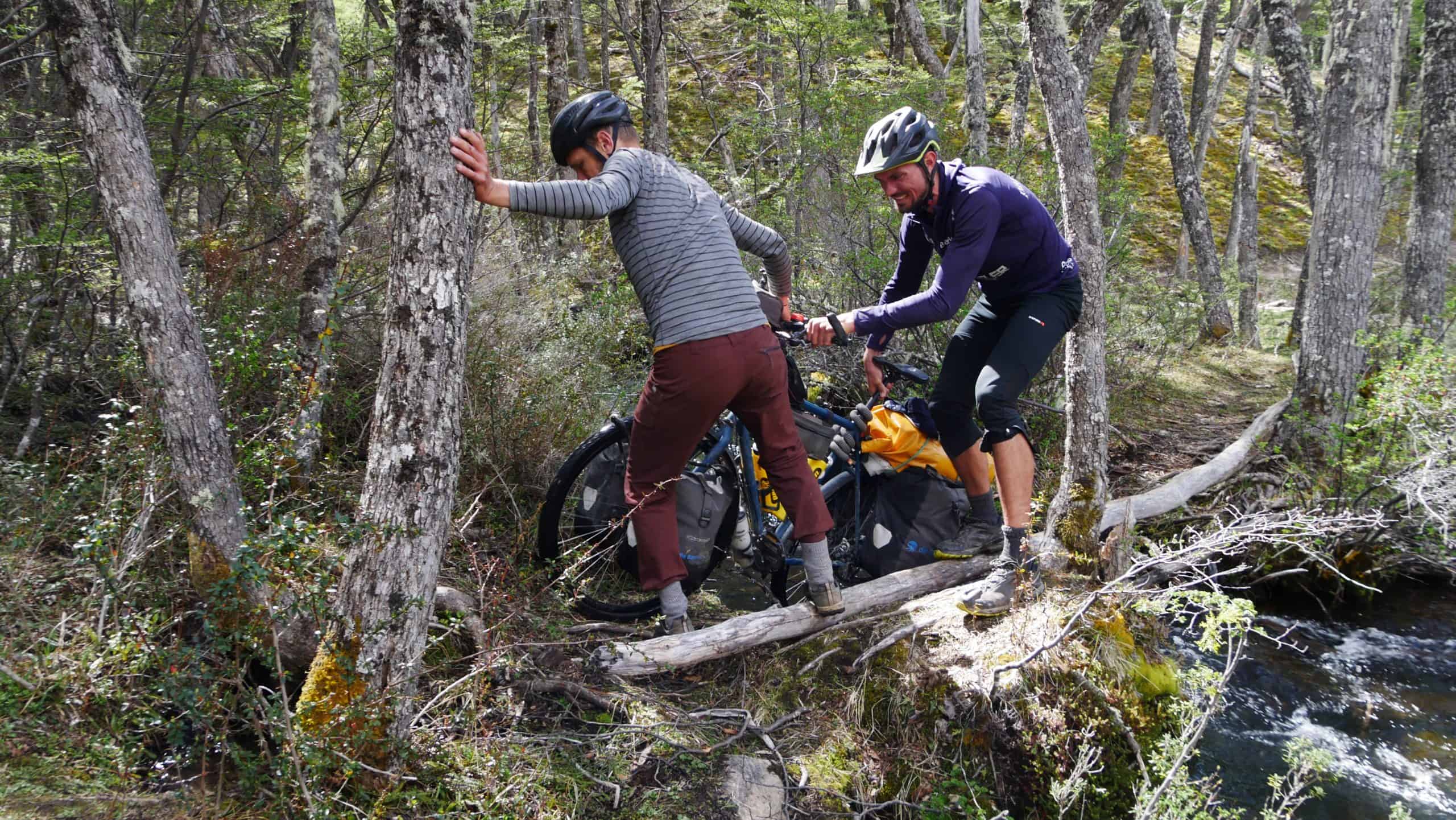
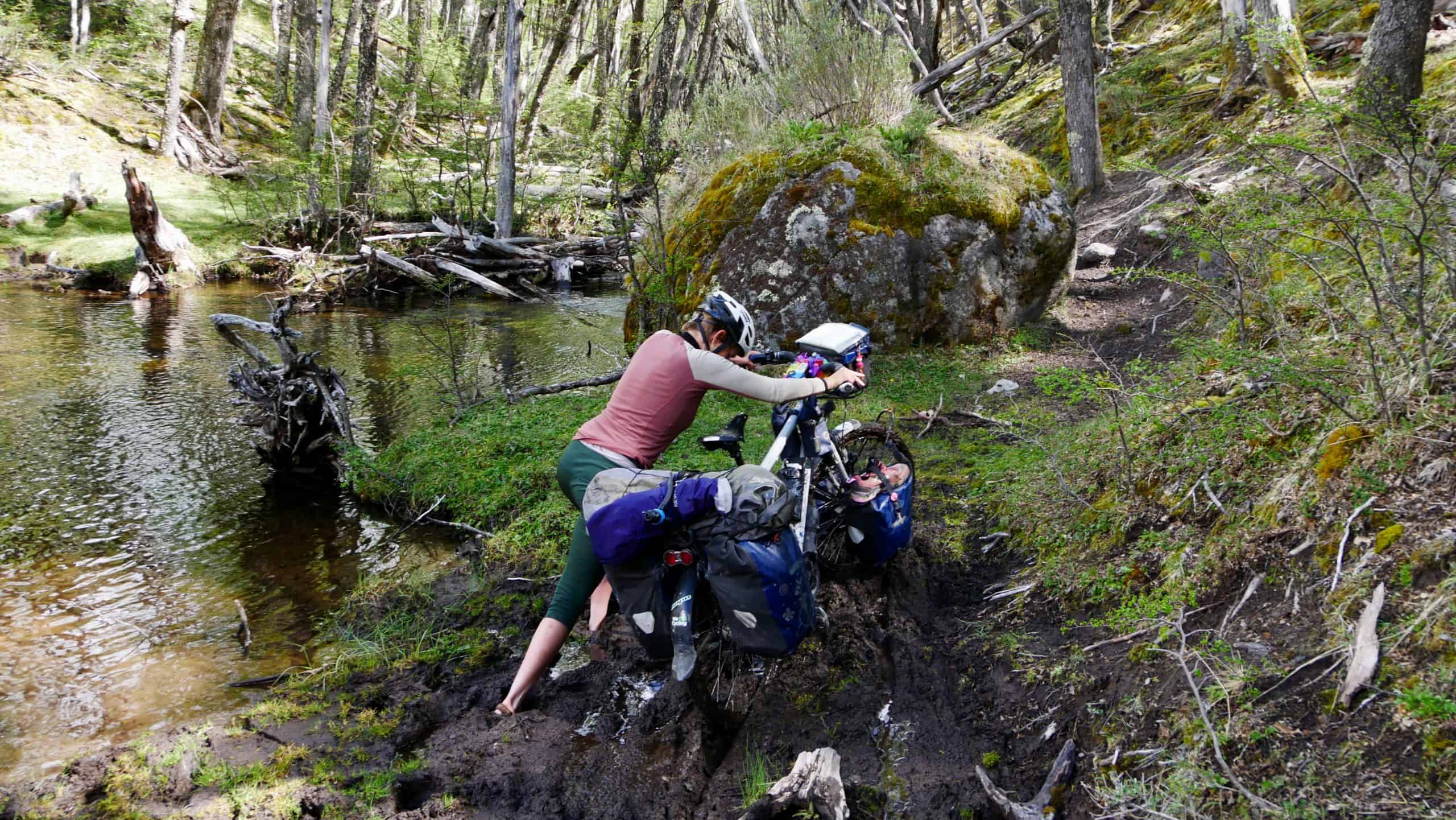
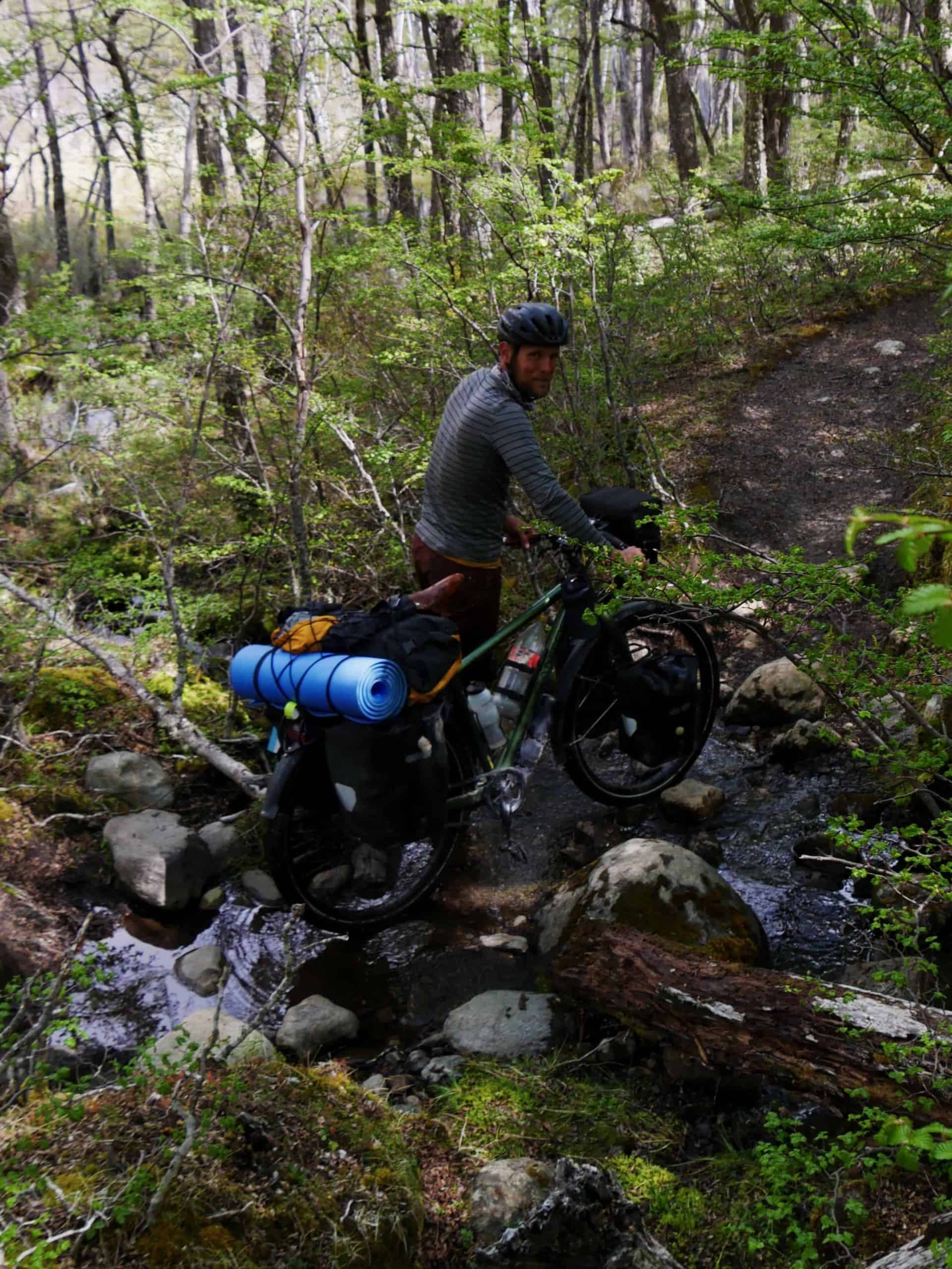
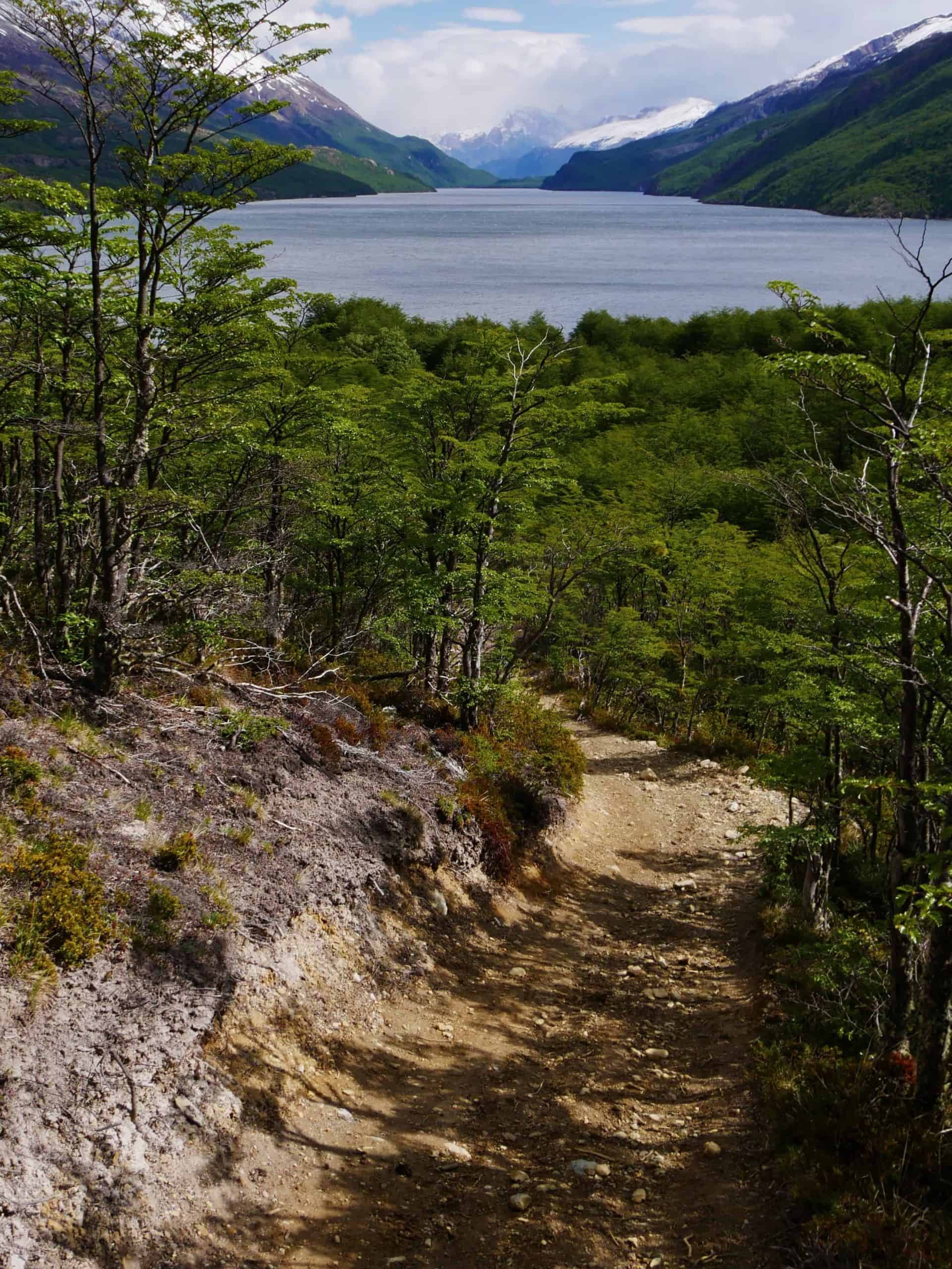
While during the climb snow still fell on us in tiny flakes, now the sun has broken through. As hard as it is, and perhaps partly because it is so hard, I am thoroughly enjoying this adventure. All this time my knee doesn’t give a hoot, it does what it needs to do just at the right time. Hooray! When Paul and I and a little later Darius reach the lake and the Argentine customs post it is 4:45 pm. Soon the others arrive as well. All just in time for the boat. Right? The customs officers ask us if we have a reservation for the boat. Only two of the group have indeed made a reservation, but for tomorrow morning. If there is no reservation, the boat will not come this way. Not surprising in itself, of course… after all, nobody lives on the piece of land between the two lakes. Fortunately, there is a beautiful lawn near the customs post with a view of the lake and the mountains in the distance. Here we pitch our tents for the night. One Spanish cyclist in his 70s has no camping gear with him. He counted on the boat and a night in a hostel on the other side. Fortunately, he can join another elderly Spaniard in his 1.5-person tent. We lend him our two yoga mats and my warm sheet bag, which he gratefully accepts. An old tough guy like him can take a beating.
While during the climb snow still fell on us in tiny flakes, now the sun has broken through. As hard as it is, and perhaps partly because it is so hard, I am thoroughly enjoying this adventure. All this time my knee doesn’t give a hoot, it does what it needs to do just at the right time. Hooray! When Paul and I and a little later Darius reach the lake and the Argentine customs post it is 4:45 pm. Soon the others arrive as well. All just in time for the boat. Right? The customs officers ask us if we have a reservation for the boat. Only two of the group have indeed made a reservation, but for tomorrow morning. If there is no reservation, the boat will not come this way. Not surprising in itself, of course… after all, nobody lives on the piece of land between the two lakes. Fortunately, there is a beautiful lawn near the customs post with a view of the lake and the mountains in the distance. Here we pitch our tents for the night. One Spanish cyclist in his 70s has no camping gear with him. He counted on the boat and a night in a hostel on the other side. Fortunately, he can join another elderly Spaniard in his 1.5-person tent. We lend him our two yoga mats and my warm sheet bag, which he gratefully accepts. An old tough guy like him can take a beating.
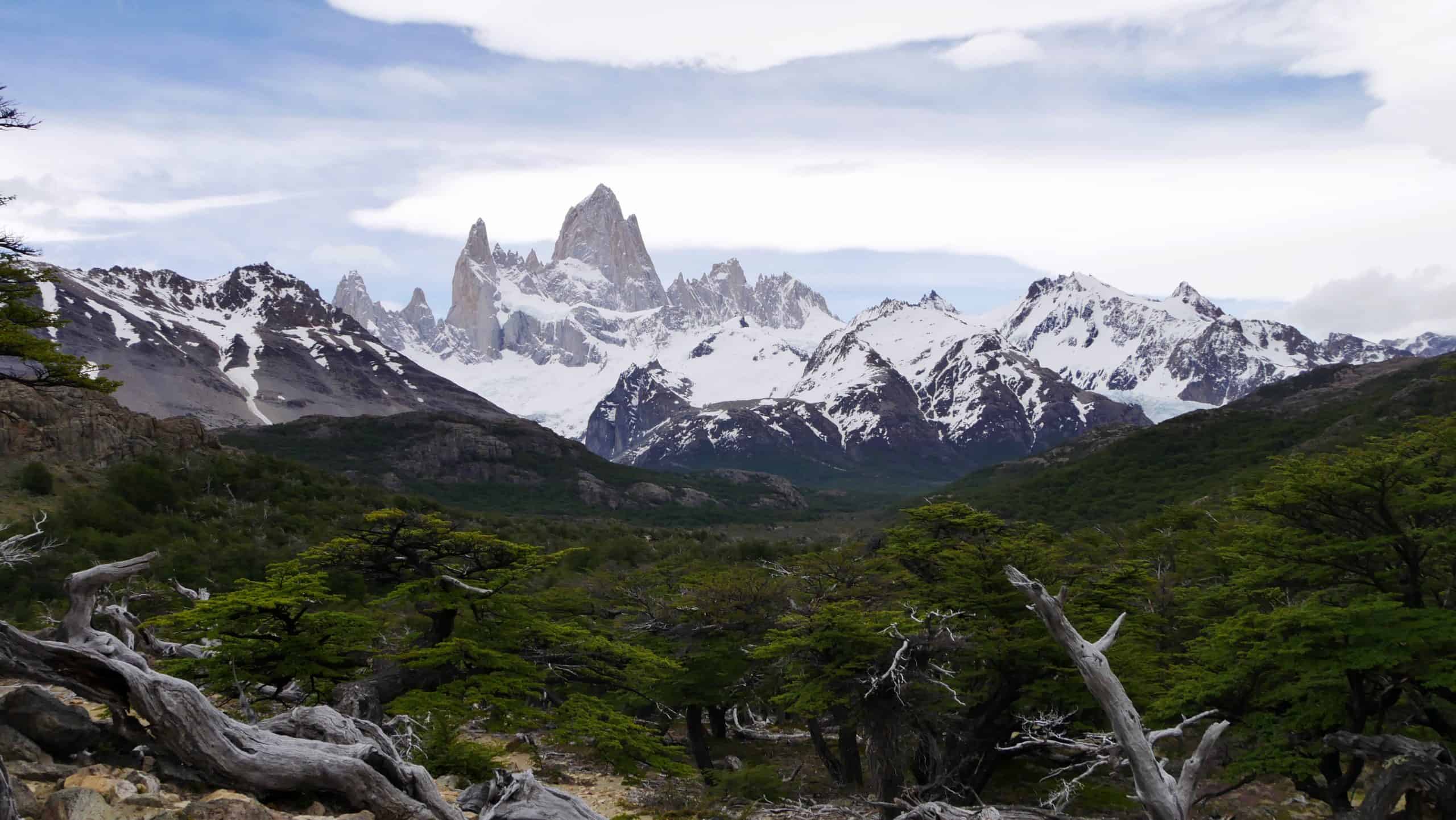

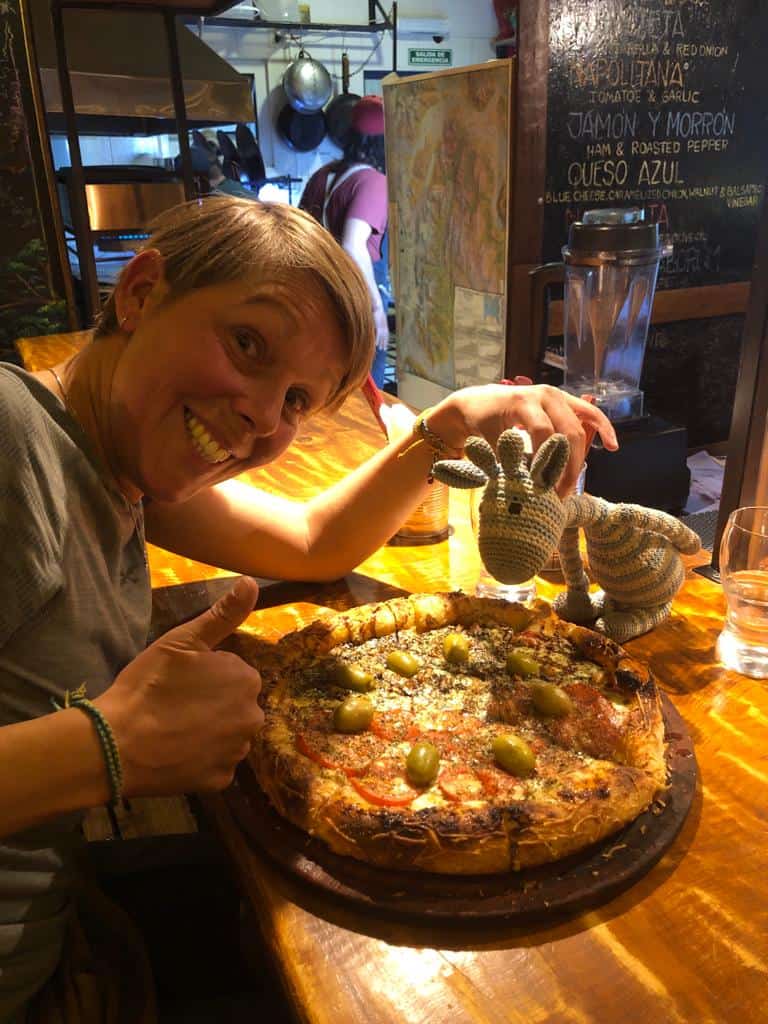
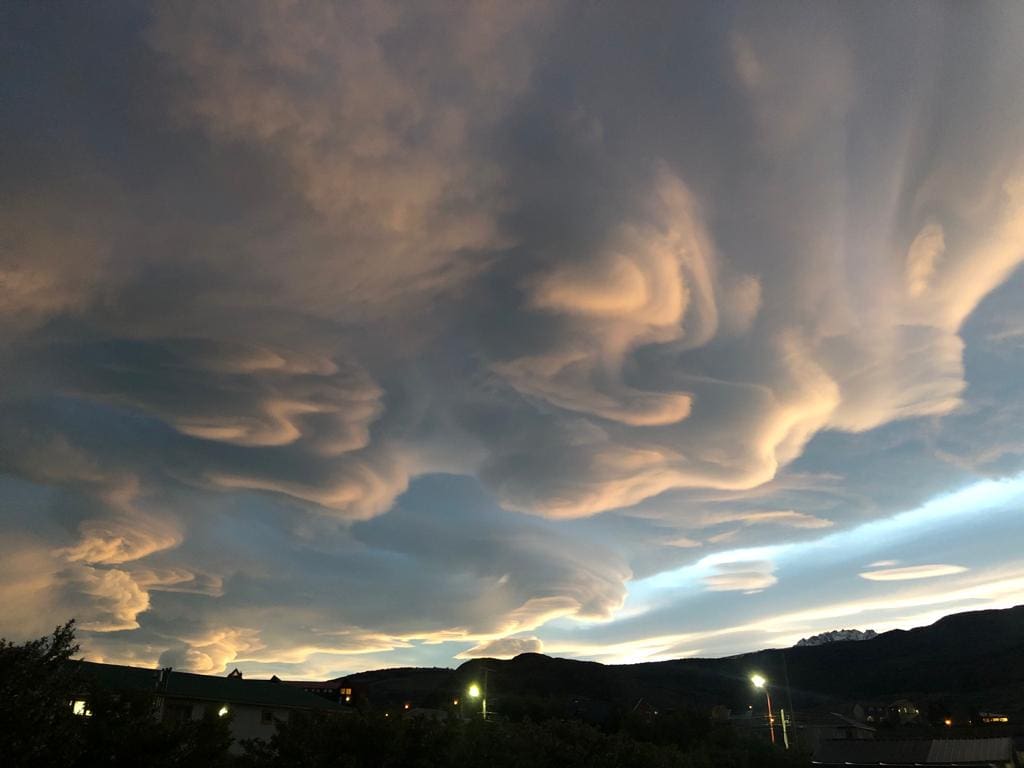
In El Chalten we rest for a few days. Paul takes another beautiful and strenuous hike with (also cyclist) Thomas. I stay at the campsite, engrossed in “Under the banner of heaven” (about (fundamentalist) Mormonism) resting my knee and occasionally glancing at the beautiful mountains that surround the village.
With our arrival in El Chalten we landed in the most touristy and therefore most expensive part of Argentina. Since most tourists are motorized from sight A to B, there is plenty of space left for us in between in quiet places. In the days between the attractions we spend the night in a beautiful glass shelter along the road (erected as a refuge from the infernal winds here in Patagonia) and we camp in the garden of a police station. In this barren environment, for lack of vegetation, we will have to seek refuge at artificial windscreens.
The next highlight is Perito Moreno. A glacier that at its outlet into the lake is as much as 5km wide and rises 70 meters above the water. Underwater, the glacier is another 100 meters deep. On a wooden boardwalk built on the opposite slope, we walk “along” the glacier. We hear the ice cracking and the water flowing through the tunnels inside it. Occasionally it rumbles as if it were thundering. Somewhere a piece of the glacier collapses. We ourselves see only a few small pieces breaking off. Still, even this gives an impressive sound. It is not difficult to spend several hours watching and listening to this extraordinary natural phenomenon.

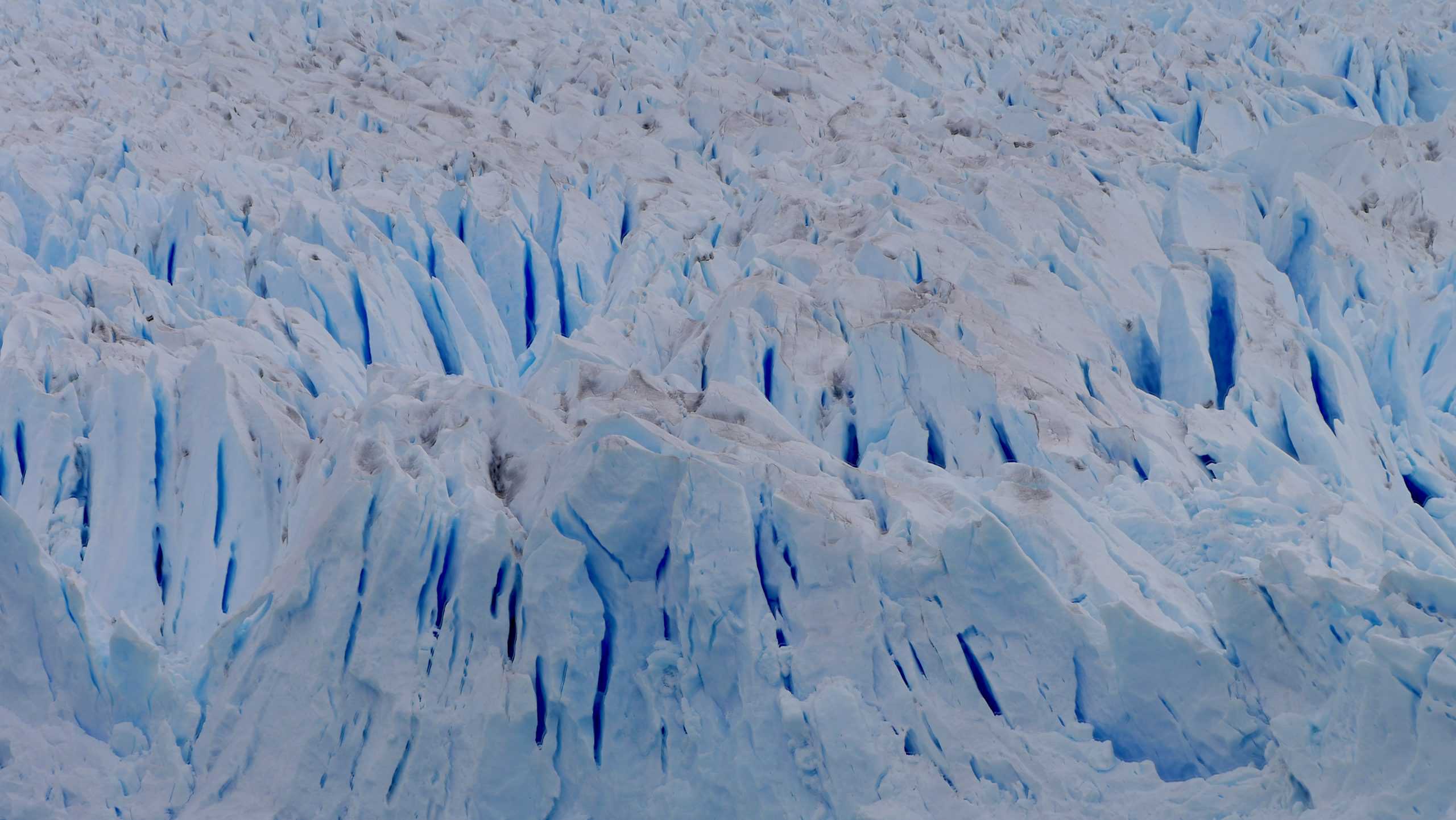
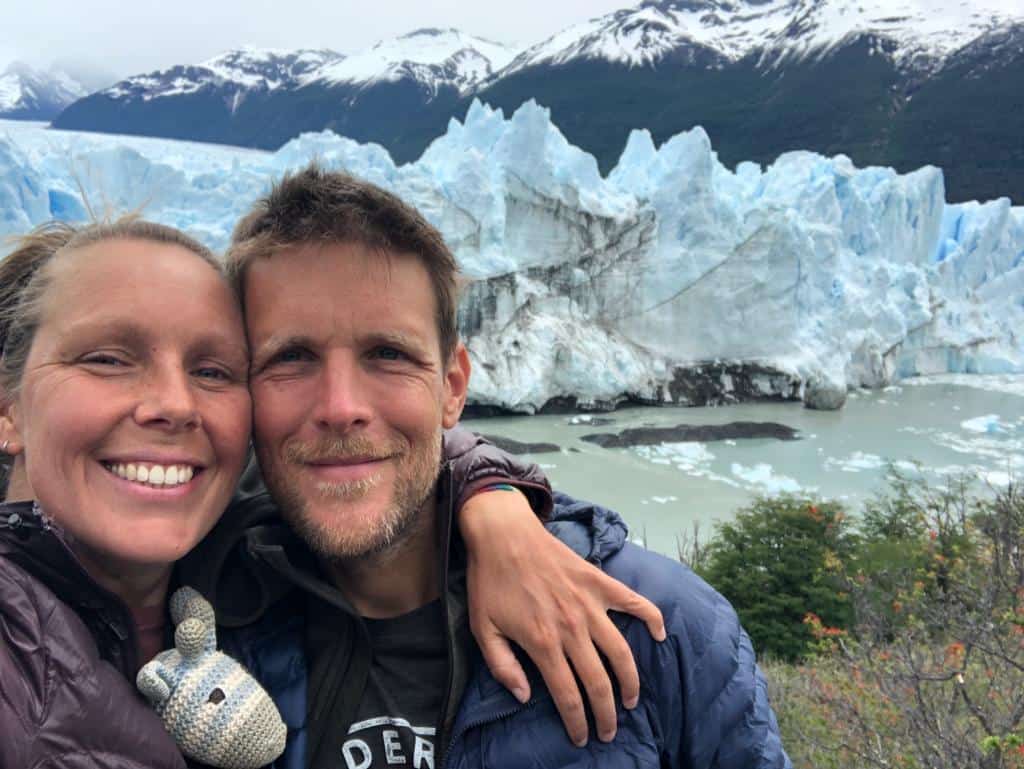
Here in Patagonia, the wind almost invariably comes from the west or, at best for us, from the northwest. On the barren plains here in the south it howls louder than anywhere else. As we cycle out of El Calafate (the village near Perito Moreno) we have the wind at our backs quite a bit. Today we ride southeast. We set ourselves no goal, yet after a few hours we notice that it is probably possible to cover the whole way to the next village, 164km away, on the same day. That would be about 100km more than we might cycle here on a windless day. And indeed, after mostly flat kilometers we roll into “La Esperanza” (or hope). A gas station, hotel, police station and about 20 houses. I don’t know where the first inhabitants had placed their ‘hope’, but it didn’t turn out to be much. We camp sheltered next to the police station. When we roll onto the road the next morning, the west wind turns out to be many times stronger than the previous day. And that while we have to go east today, to the border crossing with Chile. After unsuccessfully asking some drivers at the gas station for an elevator we pedal towards the turnoff to the border. Not much traffic passes by. In good fortune, I also raise my thumb to an approaching truck. The driver immediately steers into the shoulder of the road. A moment later we are hobbling on the bunk, sitting behind the driver and co-driver, towards the Chilean border! They drive to another border crossing and drop us off with 20km to go to the village where we want to camp. After the luxury of this elevator, I actually like the idea of fighting the wind myself. After all, that too is part of the deal … although this time it is only for 20 instead of 80 km.
In the village of Cerro Castillo, like many cyclists before us, we pitch our tent next to the (neat) bus station. Here we can stand out of the wind. At the only store in the village I do some more shopping. We set the alarm clock at 5:30 in the hope of being ahead of the wind when we ride northwest tomorrow in the direction of Chile’s pride, Torres del Paine National Park. How that goes … I’ll tell you about that in the next blog.
For now, a hearty greeting, from an relaxing armchair. New loaves are already rising next to me!
